
Errors, Freaks and Oddities
By John M. Hotchner
The following essay was originally presented in the Millenium Edition of the Linn's World Stamp Almanac, 6th Edition (2000), by Amos Press. We thank John Hotchner, who has updated it for www.efocc.org, for permission to use it here. He has also provided most of the illustrations used here.
Introduction
Errors
1. Imperforate (Perforations, roulettes or die cutting)
2. Perforations of the wrong gauge applied
3. Inverted perforations
4. Pair of full stamps with the interpane gutter between
5. Pair of full stamps with the intersheet gutter between
6. Stamps misperforated so that the interpane or intersheet gutter is placed within a stamp
7. Perforations intended to separate panes are shifted within a pane, with a full stamp width on either side
8. Perforations fully doubled or tripled
9. Fully missing color or missing tagging
10. Inverted color
11. Error of color (ink)
12. Reversed colors
13. Stamp printed on both sides
14. One or more colors leading to the completion of a stamp is fully offset on the reverse of the stamp by the blanket roller
15. Double prints
16. Inverted overprints and precancels of Bureau of Engraving and Printing
17. Wide-spaced overprints/Bureau precancels
18. Missing overprints/Bureau precancels
19. Se-tenant Bureau precancels
20. Mistakes in the overprint
21. Double overprints or surcharges
22. Full plate number or other self-contained marginal marking within a misperforated stamp or souvenir sheet
23. Full plate number or self-contained marginal marking within a miscut stamp or souvenir sheet
24. Plate number only missing when associated color-design elements are present
25. Stamps unintentionally printed on paper watermarked for another issue or not watermarked at all
26. Stamps printed on the wrong paper
27. Grills fully missing or wholly doubled and tripled
28. Gum missing from a full stamp, or present on the front of a stamp
29. Bureau repair splice creates a mismatched coil strip
29.1. Self-stick stamp images printed on backing paper
Freaks
30. Single line(s) of perforations misplaced
31. Single direction misperfs affecting all the stamps of a pane or coil, aligned with the design
32. Diagonal misperfs affecting many to all the stamps of a pane
33. Four-way misperfs (boardwalk margins)
34. Two-way misperfs
35. Individual or multiple perfs off line
36. Blind perforations
37. Lines of perforations partially missing
38. Perforations partially doubled
39. Markings from perforating equipment on stamps
40. Paper creases
41. Paper folds
42. Straddle-pane miscuts and gutter snipes
43. Booklet and coil miscuts with marginal markings, including plate numbers
44. Coil miscuts unrelated to marginal markings
45. Booklet miscuts unrelated to marginal markings
46. Souvenir sheet miscuts
47. Double paper/mill splices
48. Double paper/roll-to-roll splices
49. Bureau or other printer repairs and splices
50. Rejection markings
51. Slime holes
52. Non-error grill varieties
53. Unprinted areas in the stamp design
54. Excess ink on stamps
55. Excess ink between stamps
56. Color variations
57. Tagging varieties
58. Printing on reverse
59. Doubled impressions
60. Color misregistrations
61. Overprint and precancel problems
62. Gum varieties
Oddities
63. Essays, proofs and specimens
64. Plate varieties
65. Design errors
66. Counterfeits, fakes and intentionally created varieties
67. Rotary coil end strips
68. Flat-plate coil paste-ups
69. Private perforations
70. Semi-official separations
71. Bisects
72. Spacing and sheet layout varieties
73. Other experiments
74. Test stamps, coils and booklets
75. Printer's waste
76. Different perforations on stamps of the same design
77. Local precancel varieties
78. Perfin varieties
79. Cancellation and meter varieties
80. Pre-first-day cancels
81. Cinderellas
82. Unissued stamps
Errors, Freaks and Oddities, popularly called EFOs, are the riffraff of philately. Or they can be considered great treasures, depending upon the attitude of the collector speaking. To some, they are simply defective material, no more useful or interesting than a car that doesn't work correctly, and just as infuriating. To others, it is material that exists in only small quantities, illustrates what can go wrong in the production process, and takes the collector a step beyond the printed album page to a higher level of challenge and understanding.
In earlier days, collectors gathered EFOs to dress up their traditional collections. EFO material was mounted on supplemental pages, along with interesting cancellations and other varieties. In more recent years, EFO collecting has become a respected specialty with its own national society, literature, and specialty dealers and auctioneers.
Material included under the EFO category, and within each subdivision, is covered in this essay. Here are some elementary definitions for newcomers to the field:
Errors are total mistakes: no perforations, colors completely missing, or full stamps on either side of an interpane gutter. They are often given catalog listings.
Freaks, also called "varieties" or "minor errors" by some, represent production problems that are partial or not exactly repeatable, such as paper creases, misperforations or partially missing colors.
Errors will sometimes be found within freak pieces. For instance, a paper fold (freak) may result in a miscut booklet pane containing a pair of stamps that are imperforate between (error). Or an ink fountain on a press may have run dry, depositing a minimal amount of ink on one row of stamps (freaks) and none on the adjoining row (error).
Oddities as a class include unusual variations stemming from stamp designing through the preproduction process, and even cancellation varieties. They may be normal for what they are, but tend to be found in small quantities and are of special interest because of their properties.
The first question noncollectors are likely to ask a collector is: "Do you have one of those upside-down airplane stamps?" Of course, for the most part, they will be joking, but a collector will certainly mean it if s/he answers, "No, but I wish I did!"
The fact is that few collectors can afford the $100,000 or so it takes to add a pristine copy of Scott C3a to a collection. But anyone can own eye-popping errors and freaks that cost less than $100. It's just a matter of knowing where to look.
The first place is at the post office. Considering that the U.S. Postal Service issues more than 40 billion stamps a year and retails them through 40,000 post offices, it should not be a surprise that flawed stamps reach the public.
Every printing process has waste. The equipment has to start and stop. Because the printing process has become more automated and complex, more things can go wrong. And, of course, there is the human factor: Do something late, out of sequence, or not at all, and the result is flawed printing. It's a wonder there isn't more error and freak material on the market.
Is "99.9 percent perfect" an acceptable quality level? That's a standard that even security printers can't reach. If that standard were applied in the real world, 22,000 checks would be deducted from the wrong bank accounts every hour, 12 babies would be given to the wrong parents each day and 315 words defined in Webster's Third New International Dictionary of the English Language would be misspelled.
So, look carefully at stamps bought at the post office, from vending machines or at the supermarket checkout counter. And be alert for the person in line who is returning defective stamps and wants to trade them in "for good ones." It happens.
The next place to look is in old stamp collections - both albums and accumulations. It is amazing what has passed through many hands and before many eyes without being appreciated for what it is. This is true for many areas of the hobby but especially for EFOs.
The key is to learn about what exists. For special areas of interest, it is worthwhile to go through Scott and other catalogs and note the listed errors. The exercise gives an appreciation of color errors, perforation varieties, bicolor inverts and other flaws. Collectors who have a list in hand have a distinct advantage when visiting dealers' tables at shows or when looking at society circuit books and at auction lots. No one, including dealers, can know everything about every stamp.
There is also a brisk trade in EFOs that have been identified by others. Increasingly, dealers and auctioneers are seeking EFO material and including it in their offerings. A few well-known dealers and auctioneers aggressively advertise themselves as EFO specialists, and new discoveries and established collections tend to flow to them.
Looking at an auction catalog from Jacques C. Schiff Jr. might leave the impression that a huge amount of EFO material is in the marketplace. What it really means is that Schiff was a pioneer in this field and has built up a serious client base that generates bids. The result is that he consistently has a large EFO section in his auctions.
Those interested in buying and selling EFOs can find advertisements of EFO dealers and auctioneers in the major stamp weeklies and in many other philatelic publications.
They can also learn more about EFOs and how the EFO marketplace works by joining the EFO Collectors' Club, an affiliate member of the American Philatelic Society, which also has its own quarterly auction for members. For information, write to Stan Raugh, Secretary, EFO Collectors' Club, 4217 8th Avenue, Temple, PA 19560.
What follows is a listing of the various types of EFOs with an emphasis on U.S. material. The list has been developed by Linn's U.S. Notes columnist John M. Hotchner. A few explanatory notes and value concepts are provided for each category. There is no way to be comprehensive for all examples in each category or over the entire world. Thus these notes will include only one or two examples from U.S. philately for the most part. Valuation of EFOs is complicated. The best references are current catalogue listings and auction realizations. The value notations here are general. Actual value may increase or decrease based upon factors such as condition (exceptional, or minor flaw) the relative complexity and "visualness" of the item, and the subject content of the design. With regard to the latter, popular themes (space, baseball, etc.) will tend to push the price up.
Bear in mind that any group from these listings can be collected as a specialty, or a collector can try to obtain an example from each group. Some EFO collectors restrict their collecting to specific stamps, issues or eras. Others simply accumulate and enjoy whatever comes their way, with no particular rhyme or reason.
There is no right or wrong way. Whatever the method, your satisfaction is the only thing that counts.
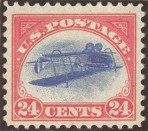
Only 100 copies of the 1918 24¢ inverted Jenny error (Scott C3a) reached the public.
Errors are the blue bloods of EFO collecting. Because many are listed in catalogs, they are sought after and generally trade at higher prices than freaks or oddities. The price for any given item depends upon its popularity and the number of examples that are known - in other words, supply and demand. Some are plentiful. An example is the imperforate-between 1 1/2¢ St. Louis precancel of the 1938 Presidential series. A pair can run as little as $10. But the Inverted Jenny, of which only only 100 copies were produced, can cost 10,000 times that. The most reliable information on pricing is from catalog listings and from current auction realizations. It should also be noted that where money is to be made, there are those who will manipulate the product to cash in on it. Buyers are well-advised to require or obtain a certificate of authenticity on expensive material from a recognized stamp expertizing organization before concluding a deal.
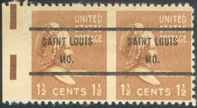
The imperforate between Scott 805b 1 1/2¢ St. Louis precancel of the 1938 Presidential series is an example of a relatively inexpensive error.
This means there is no evidence whatsoever of holes (or slits, in the case of roulettes, or die cuts, in the case of modern self-adhesive stamps).
There are three variants:
- Totally imperforate.
- Imperforate in one direction - horizontally or vertically. But remember that a coil that is imperforate in one direction is fully imperforate.
- Imperforate between two or more stamps, or between a stamp and its margin.
Imperforates generally should be collected as pairs to prove that they are not just cut down stamps.
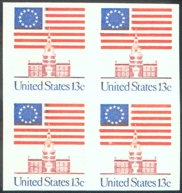
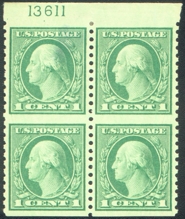

Type 1: Three types of imperforates: Upper left: Imperforate sheet stamps (Scott 1622b); Upper right: Horizontally imperforate (Scott 538c); Bottom: Imperforate between otherwise normally perforated coils (Scott 2281d).
2. Perforations of the wrong gauge applied: Several values of the 1917-19 perf 11 issues of the Washington-Franklins and the first issue of the 1922 regular series are known with all or most of the top or bottom row of perforations gauging 10. This was due to an improper repair to the perforating equipment. The stamps are rarities, but can be found in general collections. Values are in the $1000-and-up range. Expertization is essential.
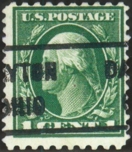
Type 2: The 10x12 perforation of this Scott 423D was created as equipment was being modified to perforate at gauge 10 from gauge 12. Such varieties exist on the 1¢, 2¢ and 5¢ values of this issue.
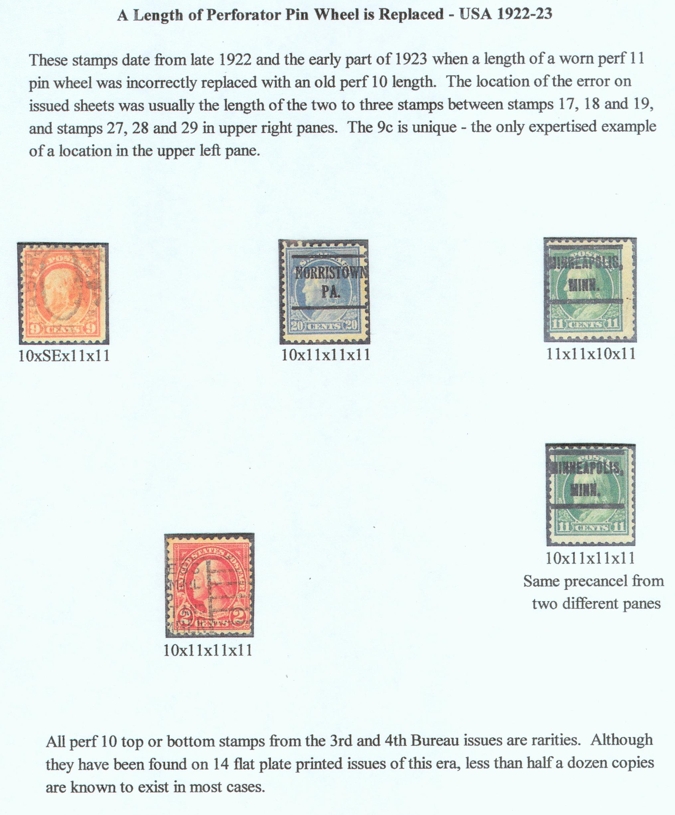
3. Inverted perforations: The only issue on which they are obvious is the 1976 24¢ and 31¢ Bicentennial souvenir sheets. These are $l,000-plus items.
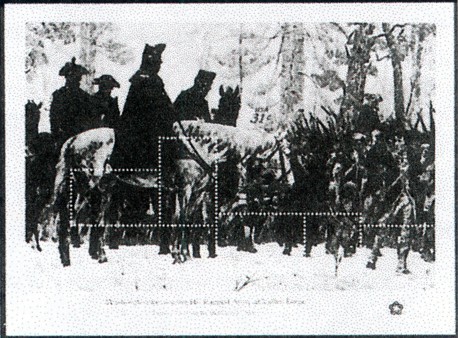
Type 3: The United States 1976 31¢ Bicentennial souvenir sheet (Scott 1689v), along with the 24¢ souvenir sheet of the same issue, is the only issue with obvious inverted perforations.
4. Pair of full stamps with the interpane gutter between: The great majority of U.S. stamps have been issued to the public in panes of 50 or 100, but they were printed in larger formats and then cut into panes. If cut incorrectly for any of several reasons, they command prices in the $100 range and up.

Type 4: Foldover with miscut results in a pair with full gutter between (Scott 1584).
5. Pair of full stamps with the intersheet gutter between: When stamp production went from sheet production to web production (printing on a continuous roll of paper), it became possible to have not just panes incorrectly cut from one another but sheets incorrectly cut. In theory, they should exist, but I have never seen one.
6. Stamps misperforated so that the interpane or intersheet gutter is placed within a stamp: More often seen than the previous category but still scarce, these are misperforated stamps that were subsequently miscut, resulting in a full intersheet or interpane margin that is within a perforated stamp shape.
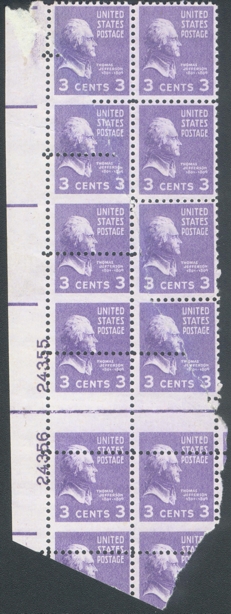
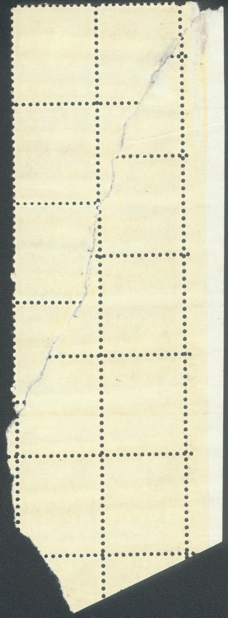
Type 6: This freak of Scott 801, caused by a web tear and repair, includes a misperfed strip of three with an interpane gutter in the middle stamp.
7. Perforations intended to separate panes are shifted within a pane, with a full stamp width on either side: This requires a major paper fold before perforating or a major misfeed of the printed sheet into the perforator. This is roughly a $150-plus item.
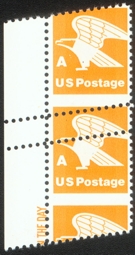
Type 7: Perforations of this Scott 725 are shifted so far that gutter perforations are within a pane, with full stamp on either side.
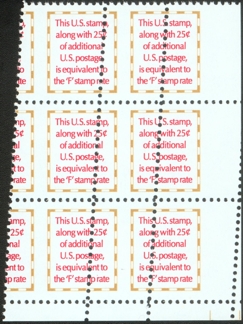
Type 7: In this case, the vertical gutter perforations are within the pane (Scott 2521).
8. Perforations fully doubled or tripled: Early examples of doubled perforations done on hand-set perforators are not scarce and can even be found on cover; priced in the $25-$40 range. Modern doubles are very difficult to find and command prices of $75 and up for a pair. A recently discovered variation is doubled or tripled comb perforating (which is extremely rare) on the 1983 wildflowers issue. A full pane should retail in the $500 range.
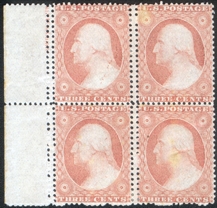
Type 8: This block of Scott 26 has vertically doubled perforations resulting from two entries into the perforator.
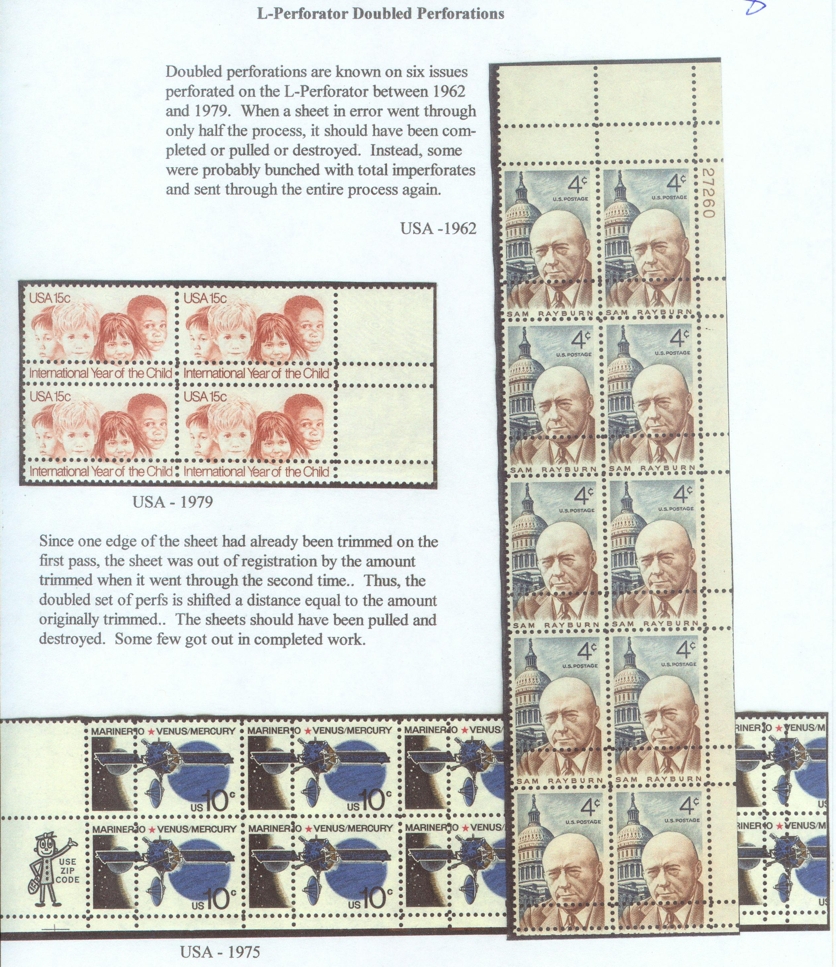
9. Fully missing color or missing tagging: To qualify as an error, every last dot or trace of color must be missing. Included in this category is tagging that has been added to a stamp as if it were another color. Pricing often reflects how obvious an error is. Thus, missing tagging, as well as missing yellows and grays, tend to have less value than the absence of a prominent color that is an integral part of a large design feature. The latter, if known on only one or a few copies, can run into the thousands of dollars, but most examples are in the hundreds. Missing backprints are missing colors but generally not of great value.
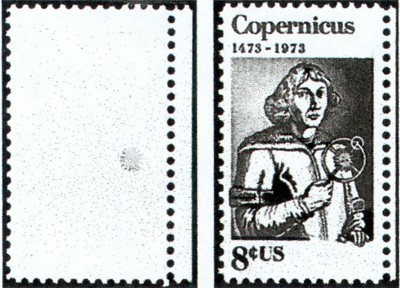
Type 9: The black ink which comprises the engraved portion of this issue, is totally missing from the stamp at left (Scott 1488b). The normal U.S. 1973 8¢ Copernicus stamp is shown at right (Scott 1488).
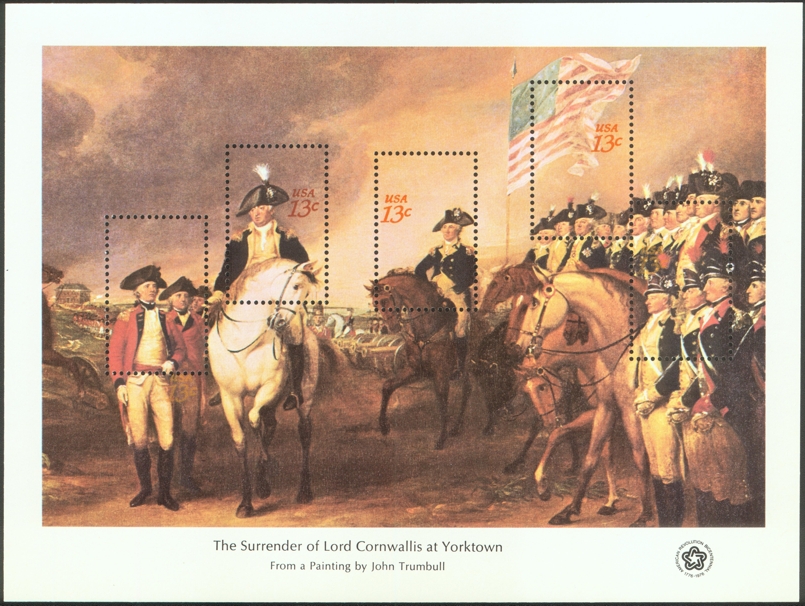
Type 9: The perforations are shifted up in this example of Scott 1686, leaving the leftmost stamp without the inscription "USA 13¢", making it also a fully color missing error according to the Scott US Specialized Catalogue (Scott 1686o).
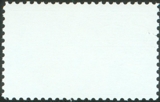
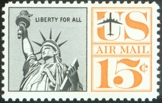
Type 9: The copy of Scott C63 on the left is an albino - all the colors have been omitted. A normal copy is shown on the right.
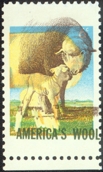
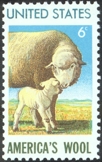
Type 9: The copy of Scott 1423 on the left is missing the engraved greenish blue due to a color shift upward. A normal copy is shown on the right.
10. Inverted color: These are the errors most likely to get the heart pounding. Inverted color errors have occurred on nine U.S. stamps, and all but one are scarce and valuable, typically bringing tens of thousands of dollars when sold at auction. The exception is the 1962 Dag Hammerskjold stamp with the yellow background inverted. When first discovered, the Post Office Department opted to ruin the value of the error by reprinting it; 40 million of the invert were released Nov. l6, 1962, three weeks after the original date of issue. There is one authenticated pane of the original find and other copies on covers dated before release of the reissue. They are valued at several thousand dollars each. The reprints, which are otherwise indistinguishable from the original, are available for pennies.

Type 10: The yellow background is inverted on this U.S. 4¢ Dag Hammarskjold stamp of 1962 (Scott 1204). It was purposely reprinted after the invert error was discovered.
11. Error of color (ink): There are a lot of color varieties but very few that are recognized as errors as a result of having the wrong color of ink applied. They range from quite scarce, such as the 1893 4¢ Columbian ultramarine error of color, to the fairly common maroon 25¢ Frederick Douglass of 1967. Values also vary widely.
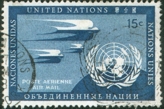
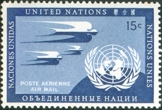
Type 11: These U.N. stamps (Scott C3a) are printed in different colors. The green-blue, so-called "Prussian blue" stamp on left is a color error.
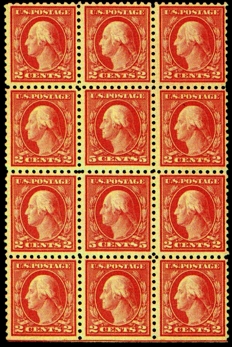
Type 11: 5¢ Scott 467 block of 12 carmine error, double error from foreign entry. "Double error" means there are two 5¢ stamps in the block of 12.
12. Reversed colors: There is only one U.S. example, the light and dark yellows on the 6¢ 1968 Van Eyck Christmas stamp. As planned, the light yellow was intended for the angel's face, hands, wings, parts of the robe and the plate number. The dark yellow was intended to be used for the trim of the robe. Because the ink was hard to differentiate, the inks were first interchanged in error; later, they were mixed as a matter of practicality. They are hard to differentiate, and the three different versions (as intended, reversed, and mixed) don't get separate catalog listings, although by rights they should.
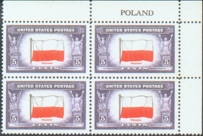
Type 12: This Poland flag from the Overrun Countries Issue of 1943-44 may be a case of reverse colors. The red of the flag has been printed over the black shading. However, we don't know whether this was done on purpose by the printer, and whether the black over red or red over black was the intended version. The entire Overrun Countries Issue is plagued by these questions.
13. Stamp printed on both sides: What is referred to here are "positive" prints on both sides caused either by a lack of care on the part of the printer or by printing on the back of waste that should have been destroyed. These are usually seen on the Banknote issues of 1851 to 1883 and are very rare and pricey.
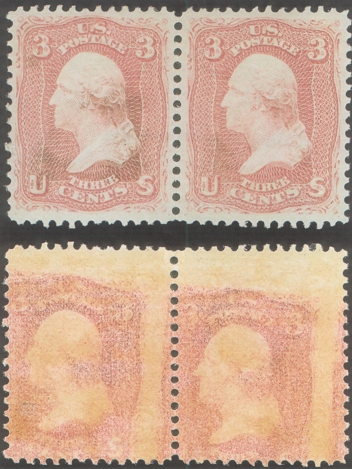
Type 13: This figure depicts a pair of Scott 65e printed on both sides of the paper. Top: Front. Bottom: Reverse.
14. One or more colors leading to the completion of a stamp is fully offset on the reverse of the stamp by the blanket roller: Compared to a stamp that has part of a design on the back in reverse due to two stamps sticking to one another and then being pulled apart, this error is a smooth, even impression well-centered on the back. It is most often found on U.S. stamps produced between 1957 and 1980 on Giori-type presses using pregummed paper. Sheets from a stack were drawn into the press one at a time. If the mechanism failed to draw a sheet into the press, the inked plate would apply the design on the blanket roller, the function of which was to maintain a consistent pressure from behind the sheet so its face would pick up a constant impression from the plate. The next sheet through the press got not only the proper print on the front but an attractive print in reverse on the back. For the most part these are not scarce and are priced in the $40-$50 range per stamp.
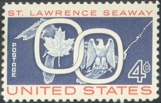
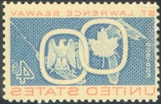
Type 14: This U.S. 4¢ St. Lawrence Seaway stamp (Scott 1131) shows a full blanket roller offset on the back.
15. Double prints: The second insertion of a printed sheet into the press - as opposed to movement of the paper and a stutter of the plate - will result in a true double impression. These usually have occurred through carelessness or perhaps when a pressman tried to strengthen a light impression. Considered scarce, they cost several hundred dollars and up.

Type 15: The red Statue of Liberty has been doubled on this 8¢ Scott 1041a.
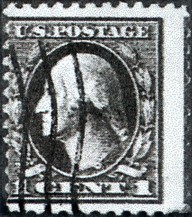
Type 15: A true double impression on a U.S. 1918 1¢ offset Washington (Scott 525d). The stamp passed through the press twice and received two separate strikes.
16. Inverted overprints and precancels of Bureau of Engraving and Printing: Two types are known. The first is the four inverted 1969 Christmas experimental precancels. The Post Office Department supplied electrotype plates for local use, and the test was tightly controlled from Washington. Yet a few panes were precanceled upside down. They are not cataloged and do not have great value. The second type is the Bureau precancels for Des Moines, Iowa; Detroit, Mich.; and Dallas, Texas, which can be found reading both up and down on the 20¢ stamp of the 1922 definitive series. None of these is rare.
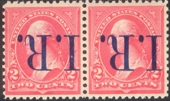
Type 16: Inverted "IR" overprint of 1898 (Scott R155c).




Type 16: Precancels on these copies of Scott 567 are sideways.
17. Wide-spaced overprints/Bureau precancels: Wide-spaced overprints are most often seen on the 1929 Kansas-Nebraska issues and on the 1959 postage due stamps. The cause was misapplication of the overprinting plate. Part of the overprint intended for a single pane of the four-pane sheet was misregistered vertically into an adjoining pane. Thus, the extra gap between two overprint rows that was intended to skip the interpane gutter then fell within a pane. These are common enough on the Kansas-Nebraskas to be valued at under $100 beyond the value of the basic stamps in most cases, but the value is considerably more for the postage dues. Certain Bureau precancels are known with the same type of flaw.

Type 17: Wide-spaced overprints, such as that seen on this strip of three of the Kansas-Nebraska overprint, occurred when the overprinting plate was misapplied.
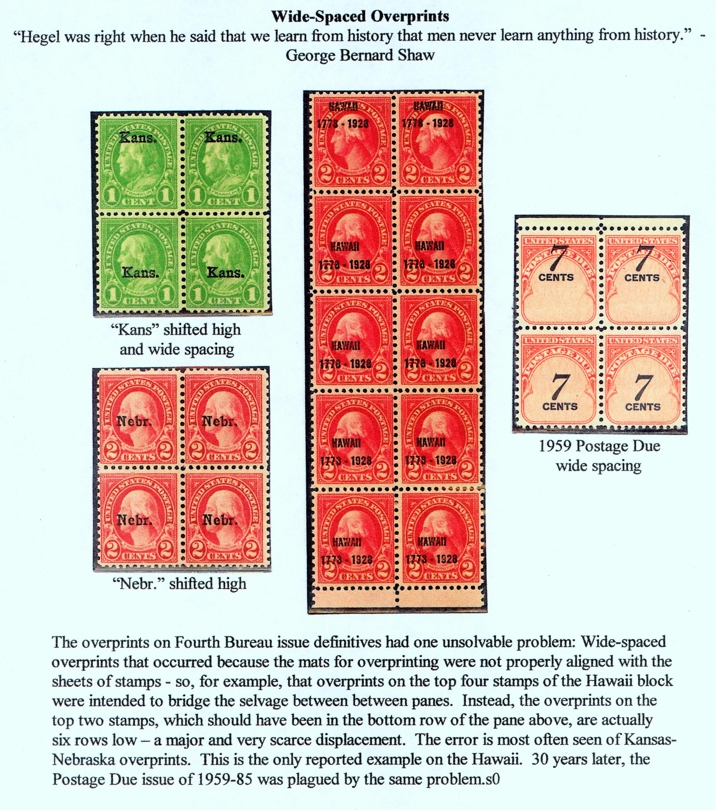
18. Missing overprints/Bureau precancels: The same problem can result in missing overprints and precancels as the overprinting mat shifted up or down. They should be collected in pairs so it can be seen just what is missing. The condition also can occur when presses run out of ink. The overprint color is missing, although the impression of the plate may be present. These can be worth hundreds of dollars and more.
19. Se-tenant Bureau precancels: Some precanceling was done by the Bureau for small cities by using adjoining precancel mats with different city names. Shifting of the mats caused different city names to be printed on adjoining stamps. These are rare, with examples ranging from $200 per pair.
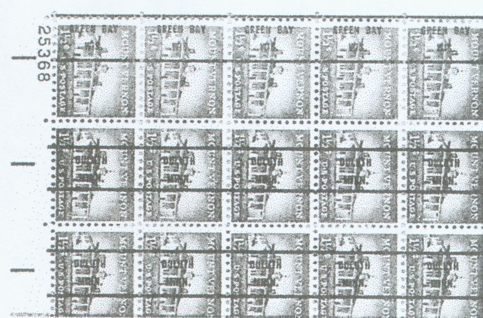
Type 19: Only known error of this Type is the 1 1/2¢ Liberty (Mount Vernon), plate no. 25366LL, on which 90 of the stamps are Bureau precanceled "Duluth, Minn.", and 10 other "Green Bay, Wis."
20. Mistakes in the overprint: There are any number of flaws, but important and constant errors are less often seen. One is the inversion of "OHIO" in some Liberty-issue Cincinnati precancels so that it reads "OIHO." Another is "Mikwaukee" instead of "Milwaukee." In other cases, periods have been omitted in abbreviations of state names. These have modest value.
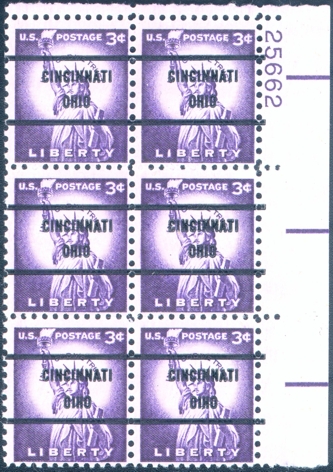
Type 20: The precancels on the bottom pair of these 3¢ Liberty stamps (Scott 1035) read "OIHO" instead of "OHIO", due to the OHIO slug being inverted when making up the precanceling mat.
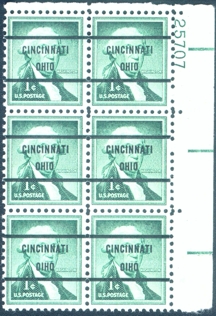
21. Double overprints or surcharges: These are quite rare. One is the $2-on-$l Shanghai surcharge (Scott Kl6a). The other is a Minneapolis, Minn., precancel on the 1954 8¢ Liberty issue. The first catalogs several thousand dollars mint or used, while the second is more in the $100 curiosity range.
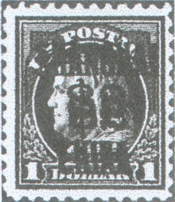
Type 21: The Shangai overprint (Scott K16a) is found with a doubled surcharge.
22. Full plate number or other self-contained marginal marking within a misperforated stamp or souvenir sheet: These are not generally considered to be errors but freaks, unless they meet the 100-percent test. Prices range from $20 for used examples to well over $100 for some mint ones.
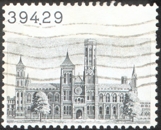
Type 22: A vertical shift of the horizontal perforations has left 100% of the plate number within a stamp (Scott 1838a). Scott also calls this a missing color, since the maroon "USA", 15¢ value and image label are all missing from the stamp.
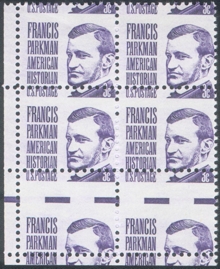
Type 22: Misperforation has left the electric eye bars within stamps of this 3¢ 1967 Parkman block (Scott 1281).
23. Full plate number or self-contained marginal marking within a miscut stamp or souvenir sheet: Most often this results from a misregistered color that puts an associated plate number somewhere into an issued stamp. Another group is miscut Transportation or Flag coils that leave plate numbers wholly on top instead of underneath the design. Another involves miscuts of the 1973 8¢ Postal Service Employees issue that leaves a green plate number on the margin of the back print. These are in the curiosity class as far as value, and most examples sell from $5 to $50.
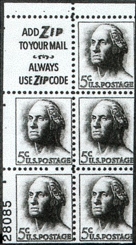
Type 23: A full plate number appears within the lower-left stamp on this miscut block of the 1962-66 5¢ Washington (Scott 1213a).
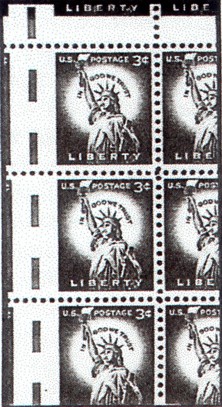
Type 23: A miscut 3¢ Liberty booklet pane with full electric eye markings shown. They are present in stamp margins to guide automated perforation (Scott 1035f).
24. Plate number only missing when associated color-design elements are present: This is known on the 1957 8¢ Magsaysay, and on miscut line pairs of the Transportation coils where the plate number below is sliced off but there is no corresponding plate number above. The latter is unusual but not rare. The former is listed in the catalog but unpriced.
25. Stamps unintentionally printed on paper watermarked for another issue or not watermarked at all: Examples are the 1895 6¢ and 8¢ first Bureau issues that were printed on paper watermarked "USIR" instead of "USPS", and the normally unwatermarked 1938 $1 Presidential that can be found printed on "USIR" paper.
26. Stamps printed on the wrong paper: Most printers pay little attention to paper except to be certain that it conforms to minimum specifications. Minor variations in paper, consistency or color are dismissed as unimportant. But on occasion from 1895 onward, exceptionally thin paper was used, usually as an experiment, and released with general production. The best known is the 3¢ Presidential horizontal coil, which can run as little as $20 per stamp.


Scott 158 on ribbed paper. Note faint vertical lines resembling laid paper, but not so pronounced.
27. Grills fully missing or wholly doubled and tripled: Because most collectors don't look that carefully at the back of stamps, these can still be found on the 1861 issue, the 1869 Pictorial issue and Large Banknote issue for the price of the normal stamp. Used copies retail quite a bit under $100 on common stamps.
28. Gum missing from a full stamp, or present on the front of a stamp: Gum skips need to be collected in large enough blocks to assure that one can see where the gum starts and stops. Otherwise, a single stamp with gum washed off could be passed off as the error. Even when a block is offered, it is seen as a curiosity by most, and value is slight. The same is true for those few stamps that have been gummed on the front instead of, or in addition to, the back. The 1934 6¢ National Parks is known with gum on both sides.


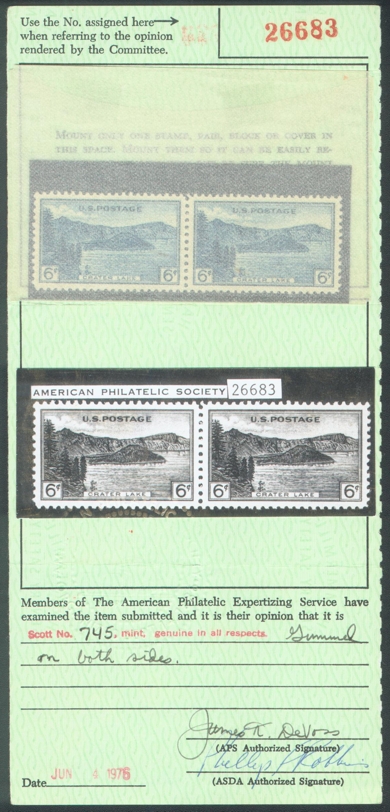
Type 28: The Scott 745 shown above is gummed on both sides. This is not possible to see as displayed here, therefore an expertization certificate is useful.
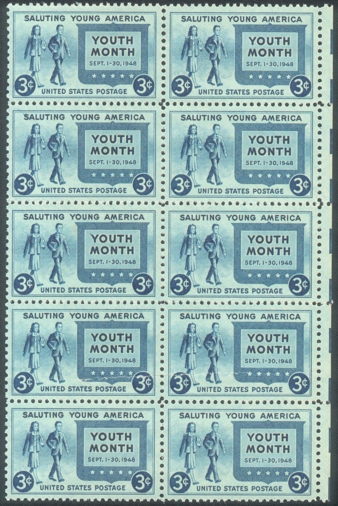
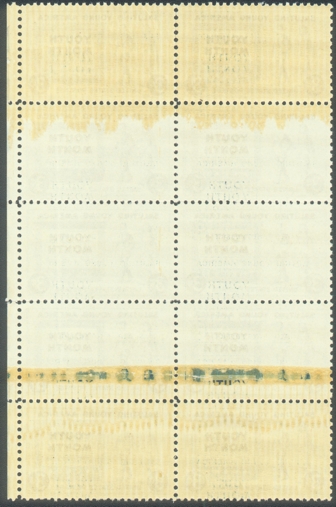
Type 28: The Scott 963 block shown above has a gum skip that can be clearly recognized, because the edges of the skip are visible. The center horizontal row is totally without gum. The 2nd and 4th rows are also examples of Type 62, Gum Varieties.
29. Bureau repair splice creates a mismatched coil strip: Repair splices are freaks, but one is known that attaches two different coil stamps, the 17¢ Electric Auto and the 20¢ Flag Over Supreme Court. It is unique and priced as such.

Type 29: The 17¢ Electric Auto and the 20¢ Flag Over Supreme Court are spliced together to create a mismatched strip.
30. Single line(s) of perforations misplaced: This occurs when a single pinwheel is missing, not tightened down, or set incorrectly. It is common on the edges of sheets of 19th century stamps. Value is modest to perhaps a $25 premium for a particularly nice example.
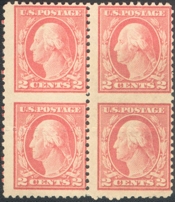
Type 30: The 3rd Bureau 2¢ block (Scott 499) has its horizontal center perforations shifted into the bottom stamps, probably due to a loose pin wheel. The perforations are impressed but not punched through.
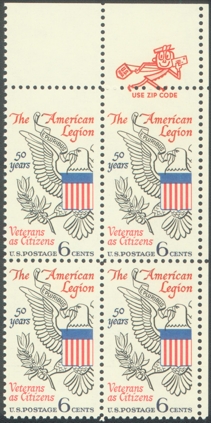
Type 30: The outside row of horizontal perforations was set too wide on this L-perforator product (Scott 1369).
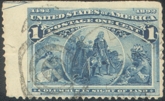
Type 30: As in the above figure, the outside row of horizontal perforations was set too wide here, too (Scott 230).
31. Single direction misperfs affecting all the stamps of a pane or coil, aligned with the design: There are two types. Simple misperfs are quite common. They usually run from $5 to $15 if the design is cut in half by the perfs. However, many people think of them as being defective stamps rather than collectible freaks. The other type is design-change misperfs. They are like simple misperfs, but the perfs shift in just such a way as to change the design. As an example, the inscription will appear on the wrong end of a stamp. Nice examples can go to the $30 range.
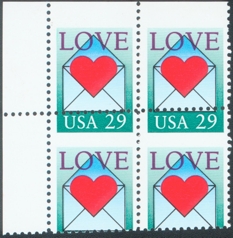
Type 31: The horizontal perforations are off equally throughout the pane, creating a "design misperf" (Scott 2618).

Type 31: Two way misplacement of the die cuts (The grid was added digitally to show where the die-cuts are located).
32. Diagonal misperfs affecting many to all the stamps of a pane: Diagonal perforations usually occur when a sheet is misfed into, or tears within, a perforator. They are relatively scarce and, depending upon the angle, a stamp can go as high as the $75 range for a pair, and more for blocks.
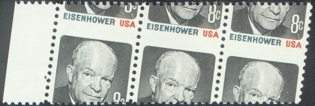
Type 32: Horizontal perforations are on a diagonal; each stamp is different (Scott 1394).
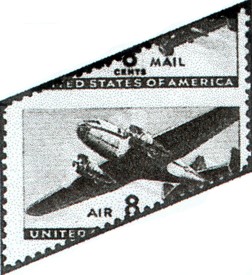
Type 32: This is an example of diagonal misperforations on the 1941 8¢ airmail (Scott C26).
33. Four-way misperfs (boardwalk margins): Hand-set lines of perforations in the 19th century sometimes produced large, relatively equal margins around the outside of stamps. They are quite scarce, often commanding many times catalog value.

Type 33: The exceptionally large and relatively equal margins on this 2¢ Washington are known as “boardwalk” margins.
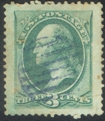
Type 33: COMPLETE.
34. Two-way misperfs: Either poor insertion of a sheet into a perforator, or automated perforating that was not yet synchronized to marginal guide markings intended to focus the perforations in the proper location, could result in both horizontal and vertical perforations being off true to varying degrees. Most are relatively minor and average $10 to $15 a stamp.
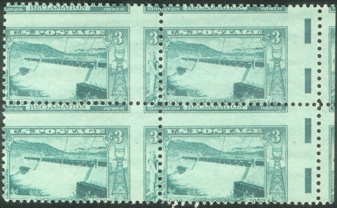
Type 34: A common type of two-way perforation shift can be seen on this Scott 1009.
35. Individual or multiple perfs off line: A bent or defective perforating pin, or a damaged row of perfs, can result in one or more perforations being off line. Considered to be of little importance, they seldom bring more than $10 a pair.

Type 35: A bent perforator pin caused this misaligned perforation.
36. Blind perforations: These are perforations that have been punched but not punched out. At first glance, the stamp appears at least partially imperforate. This is common on some issues, not so common on others. In either case, value tends to be minimal. Blind perforations can sometimes be found as a lead into or out of an imperforate section of a pane where the perforator was fully disengaged. Such a piece is called a "transition piece."
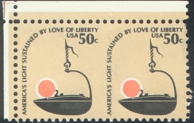
Type 36: This example of Scott 1608 has blind vertical perforations. They can be seen more clearly if you look at the enlargement by clicking on the picture.
37. Lines of perforations partially missing: This was initially caused by damage to the perforating wheel. In more recent times, it resulted from perforating mechanisms engaging or disengaging at the start or end of production, or for other reasons. Value varies with the item affected and the degree of the problem but only really unusual examples exceed $25.
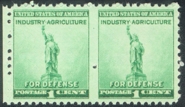
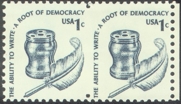
Type 37: Examples of partially missing perforations: Left: Scott 899, right: Scott 1581.
38. Perforations partially doubled: In the 19th century, perforator operators might withdraw sheets that were inserted off true, and reinsert them to do it right. Because paper was far more expensive than it is today, those doubly perforated sheets tended to be issued. Blocks might go into the $75 range for an average stamp and increase for more expensive varieties. Another category that is seen less often is partial rows of perforations in the margins of large Banknote issues. It is likely that these were caused by extra pins stored in those positions against the need for replacements as pins in the normal settings broke. Single used examples run in the $25 range, more for higher-value stamps or mint examples and blocks.
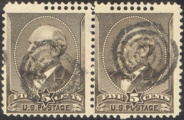
Type 38: This example of Scott 205 has partially doubled perforations resulting from storage of extra pins to replace pins that broke.
39. Markings from perforating equipment on stamps: Stripper marks, from built-up ink on the mechanism that pulls the paper through the pins, are sometimes seen, especially on regular issues of the last 40 years. They have little worth beyond their curiosity value. An item with moderate value, but rarely seen, is the "smallpox" Gilbert Stuart "George 'Washington" coil of 1932. It came about because the Bureau of Engraving and Printing had to add linseed oil to a batch of unsatisfactory ink to make it usable. That lengthened drying time just enough to let rollers feeding the web of printed stamps through the perforator to pick up wet ink and deposit it later on trailing stamps. They are not easily detected and are hard to find. Value is $20 or so for a used copy.
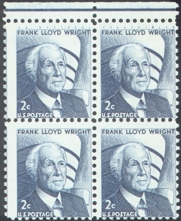
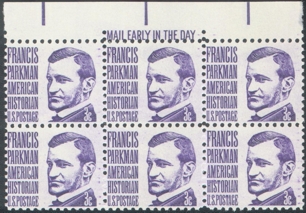
Type 39: Left: Scott 1280. Right: Scott 1281. Both blocks show stripper marks across the top of the upper pair of 2¢ stamps, and in the right margin of the 3¢ stamps.
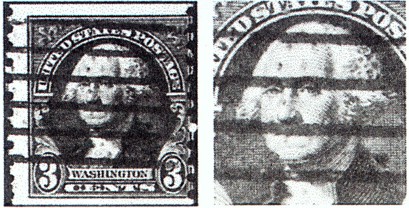
Type 39: The Gilbert Stuart "George Washington" "smallpox" coil (Scott 721).
40. Paper creases: Creases are internal pinches in the paper that when opened up are seen as a white unprinted space. Value depends upon the size of the pinch, the stamp affected and the number of stamps affected in the piece. The normal occurrence is to have a pinch running through most of a pane if not all of it. Another variation is a pinch in the paper after printing but perfore perforation that results in a discontinuous line of perforations when opened up.
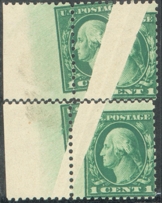
Type 40: A paper crease that occurred before printing was opened up before perforating (Scott 498).
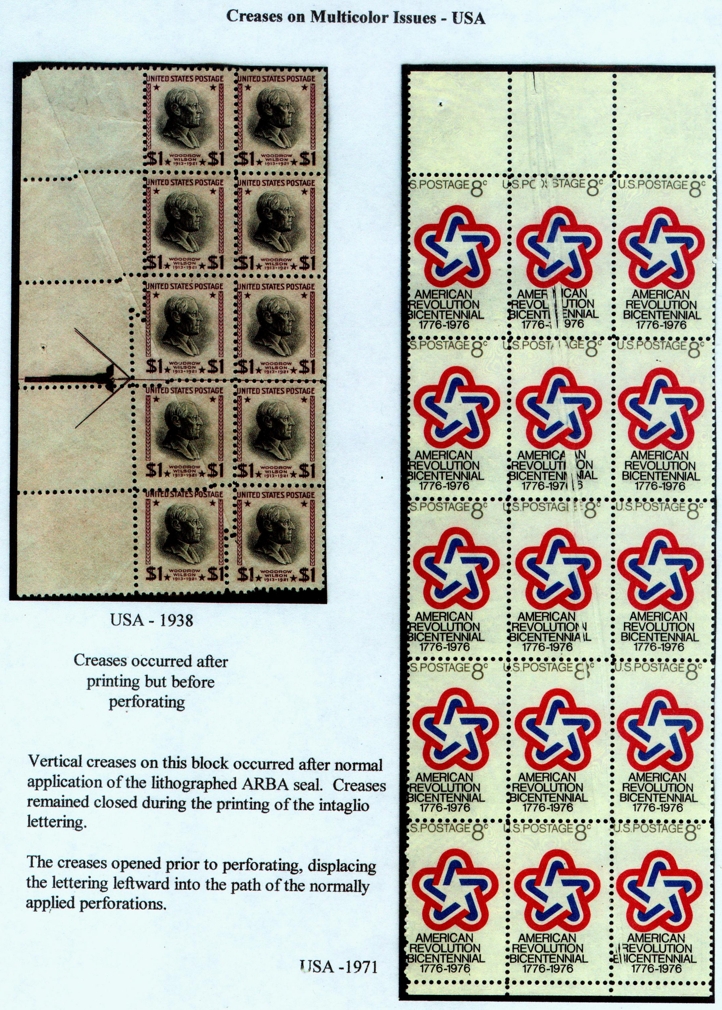
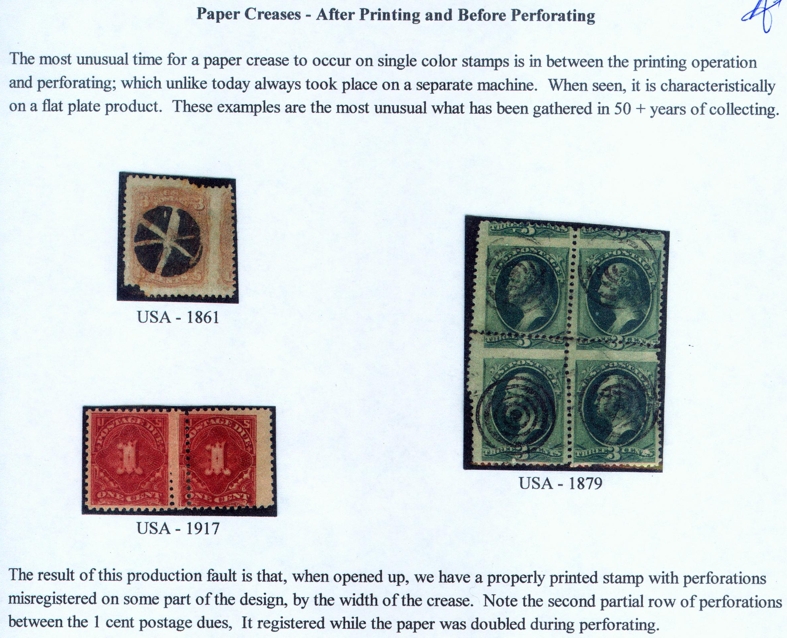
41. Paper folds: A paper fold normally involves a comer of a pane that has been inadvertently folded under or over. They can be minor, involving only a bit of margin, or major with many stamps involved. If the fold goes through printing or perforating, the results can be spectacular, with printing gaps and "crazy perfs" resulting. Prices of such material can reach several hundred dollars for visually interesting multiples.
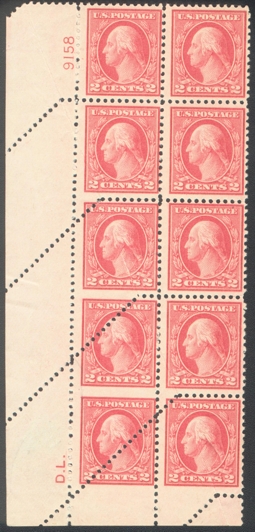
Type 41: A simple fold between vertical perforating and horizontal perforating created this example of "crazy perfs" (Scott 499).
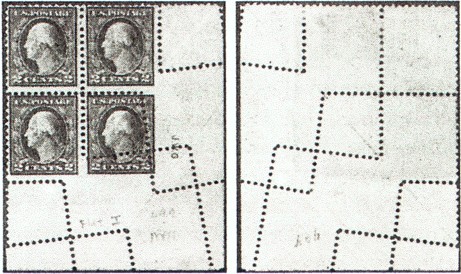
Type 41: This complex fold took place before both horizontal and vertical perforating, and the paper actually folded twice (Scott 499).
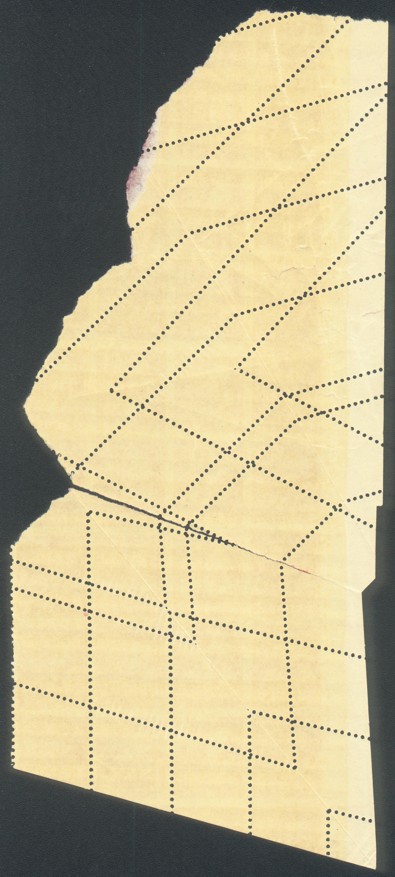
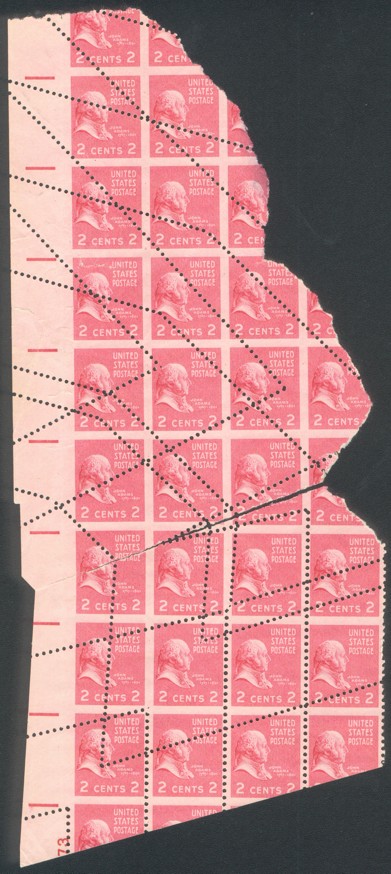
Type 41: This piece of 2¢ Adams (Scott 806) printer's waste was torn, folded and "chewed up" as it was inserted for perforating, creating what is known as "crazy" perforations.
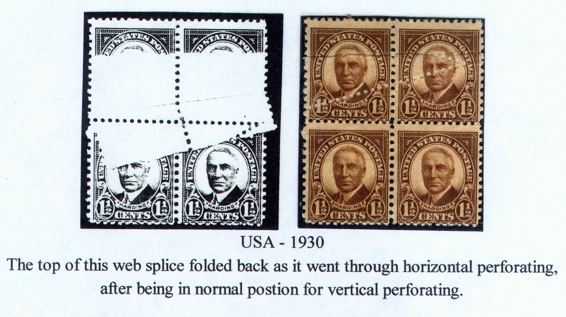
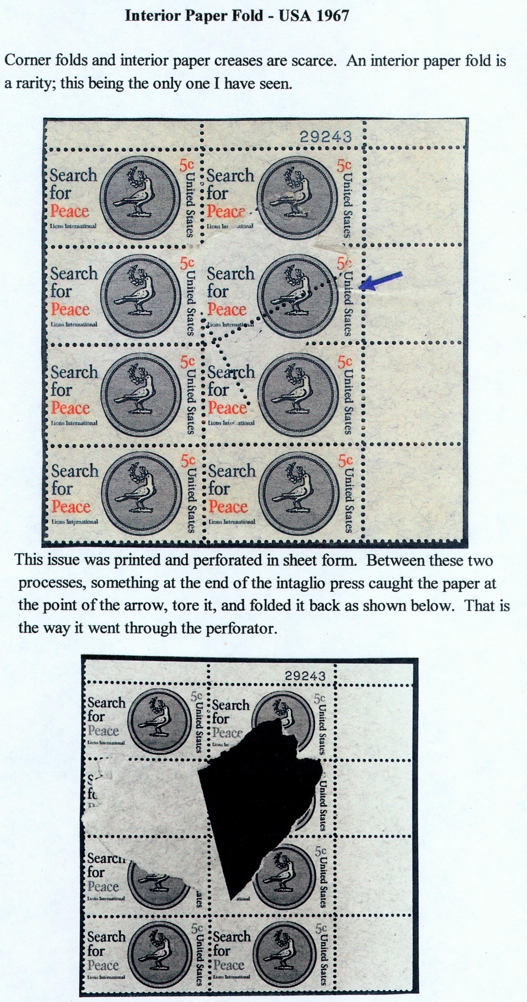
42. Straddle-pane miscuts and gutter snipes: Stamps have always been printed in formats larger than the panes issued at the post office. The consequences of something going wrong as sheets were cut into post office panes have been noted in the Errors section, but of lesser importance are freaks that result in only partial stamps from adjoining panes. Early sheets did not have perforations between the panes - only a small imperforate space with a line to guide the cutting. Stamps showing that complete imperf space and part of an adjoining pane are called straddle-pane copies, and have value depending upon the stamp and the degree of the miscut. Later, when perforated margin between panes became the rule, miscuts could go to the edge of the far margin and beyond into the next pane. These are called gutter snipes, and the basic price for "perfs only" from the adjoining pane is 50¢ to $1 per stamp. The price goes up as the size of the stamp from the adjoining pane increases.
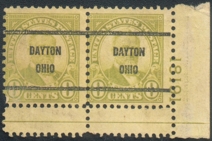
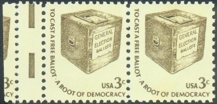
Type 42: These "gutter snipes" show perforations, and in the case of the 3¢, a bit of the stamp from the adjoining stamps (Left: Scott 640. Right: Scott 1584).
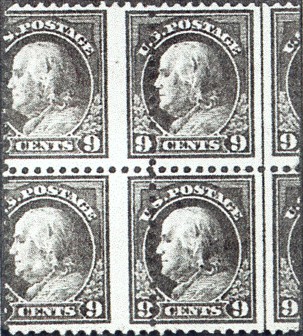
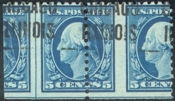
Type 42: These are examples of straddle-pane miscuts resulting from vertical misperforations. In the 5¢ on the right (Scott 504), the precancelling registered perfectly. On the left, a 9¢ Franklin (Scott 509) miscut.
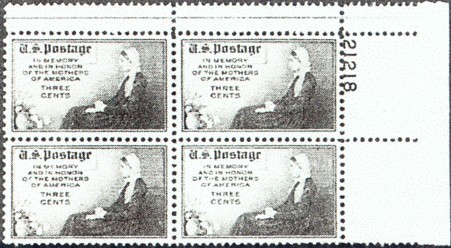
Type 42: Gutter snipes typically are caused by misregistration of the cutting device or paper foldover. This is an unusual example - an intersheet snipe (Scott 737).
43. Booklet and coil miscuts with marginal markings, including plate numbers: These margin miscuts are common and have value according to the percentage of marking shown. If it is a plate number, value may be affected by the scarcity of the number itself.
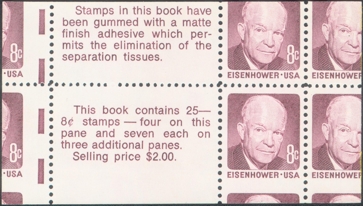
Type 43: A miscut pane of Scott 1395 with partial stamps showing electric eye markings.

Type 43: An example of Scott 1906 with partial stamps showing partial plate number above the design.
44. Coil miscuts unrelated to marginal markings: Interior miscuts will result in stamps showing parts of two stamps. The value depends on the degree of miscut.

Type 44: The coil line strip depicted in this figure is not only miscut, but also imperforate (an error of Type 1) (Scott 1402).
45. Booklet miscuts unrelated to marginal markings: Like coil miscuts showing parts of other stamps, booklet panes can be miscut in the same way. But there is a particular problem with another series of freaks: the 1981 18¢ Purple Mountain Majesties booklet. On this, miscutting created panes with perforations on the outside of the pane and an imperforate center vertical row. Otherwise normal-looking panes had the vertical-length register mark on the left instead of the right. The former catalogs $75. The latter runs in the $35 range.


Type 45: This 22¢ Flag booklet was cut into booklet after the stamps had been placed in the booklet cover, with the booklet cover shut.
46. Souvenir sheet miscuts: Souvenir sheets have nearly always been cut from larger-format printing sheets, and miscuts have been quite scarce, probably owing to the significant degree of individual handling required.
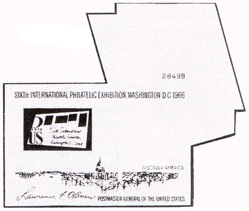
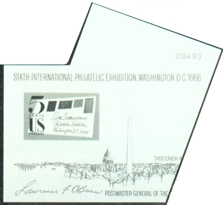
Type 46: 1966 SIPEX printing sheets, each containing 24 souvenir sheets, were folded prior to being cut into individual souvenir sheets, causing the above freaks (Scott 1311).
47. Double paper/mill splices: Double layers of paper can occur at the paper mill or in the stamp-production process. The former happens because the paper mill has accepted an order for a web, or roll, of paper that will feed through a press at high speed. In the process of making the web, overlaps occur. Stamp production equipment has sensors to detect such flaws so that they don't damage the sensitive printing equipment and so that the double papers can be identified and excised. Mill splices can be identified by either the type of adhesive used to bond the overlap, or by the red plastic tape used by some manufacturers for this purpose. Both are quite scarce, typically running $75 and up for a block of four or more. They are very difficult to get apart.
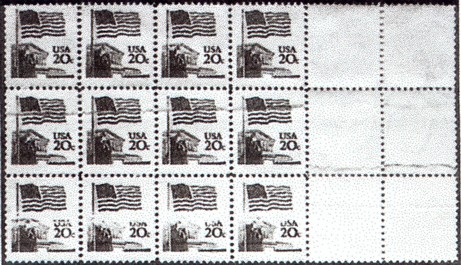
Type 47: The mill splice on this 20¢ Flag Over Supreme Court block (Scott 1894) consists of overlapping paper being held together by two sided blue tape. Because the bottom part of the paper is folded up, the third horizontal row of perforations went through four thicknesses. Note that the edge of the splice has interfered with the printing of the top of the Supreme Court building in the bottom row.
48. Double paper/roll-to-roll splices: Much more common is the splice that occurs while stamps are being printed. To make certain that production can continue uninterrupted, one web is spliced to another during production. Automated equipment should detect the splices after printing and mark them for destruction just like mill splices. In the era of the Presidential series, however, many of these got out of the Bureau of Engraving and Printing. A block of four normally sells for $20-$25. Flawed stamps, printed on double paper, come apart easily. They will be found at the trailing end of one web. Blank stamps will appear where paper above received the impression.


Type 48: A roll-to-roll production splice, seen here on a block of Scott 810 and common in the Presidential era, is characterized by overlapped paper held in place by two lines of cellophane tape, which, over time, shrank, pulling the design put of alignment. Note also the red grease pencil marking across the fourth row. This is a rejection marking put there to indicate this part of the web should be excised and destroyed.
49. Bureau or other printer repairs and splices: Paper is fragile and can be torn by production equipment. Since the advent of rotary printing in the early part of the century, it has been the practice of the Bureau to make repairs and go on with production, salvaging what could be used and destroying the rest. This is especially important with web production, where rethreading of the press is to be avoided at all costs. But repairs are found on sheetfed-press products too. Typically, kraft paper was used for most repairs through the 1922-38 series, but all sorts of other paper can also be found. In the 1960s, Scotch tape was used for repairs, along with red plastic tape and clear plastic tape. All such material is scarce because all repairs were intended to be destroyed. Value depends upon the size of the piece and how visually striking it is. It might run from $25 for a simple coil pair to hundreds of dollars.


Type 49: Red platic tape was used on this booklet (Scott 3886b) to repair a web splice. Splices are intended to be excised from finished work.
50. Rejection markings: The identification of flawed material that is to be rejected ranges from hand-placed markings in earlier days to automated markings developed in modern times for specific processes. Most earlier material was marked for rejection by red grease pencil, which gave way to black markers. In the 1950s and 1960s, a black spray was often used, and some coils were actually slit in the center to mark them for destruction. Except for the Presidential-era definitives double paper, all material marked for rejection is scarce. It tends to be underpriced because it's not a popular collecting area and collectors often don't know what it is when they see it.
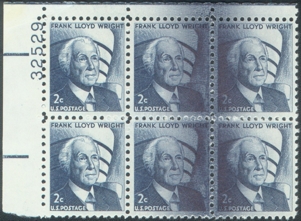
Type 50: A spray rejection marking is shown on the 2¢ Wright (Scott 1280).

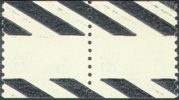
Type 50: The purple and black printed marks on the back of the coil pair (Scott 1895) are rejection markings.

Type 50: The rejection markings on this E-rate stamp (Scott 2277) were hand-applied with a magic marker.
51. Slime holes: Slurry, the mixture of water, chemicals and pulp or other fibers used to form paper, can develop clumps of bacteria that turn into slime. A slime spot on the slurry when it is spread out on the screen to make paper will become an irregular hole in the finished paper. On rare occasions, the damaged paper will make it through printing and distribution. Value is in the $25+ range for a small example, but try to find one!
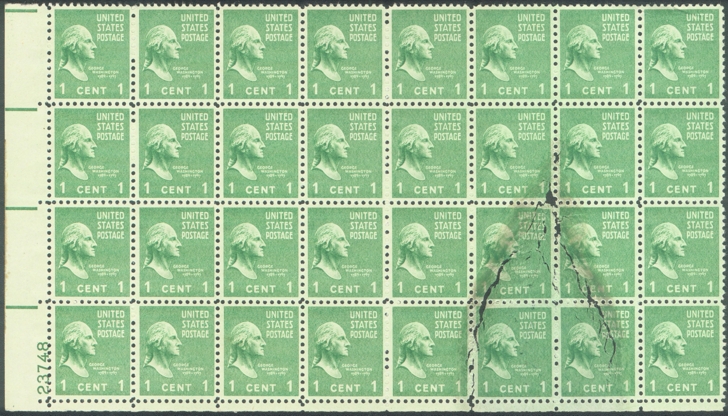
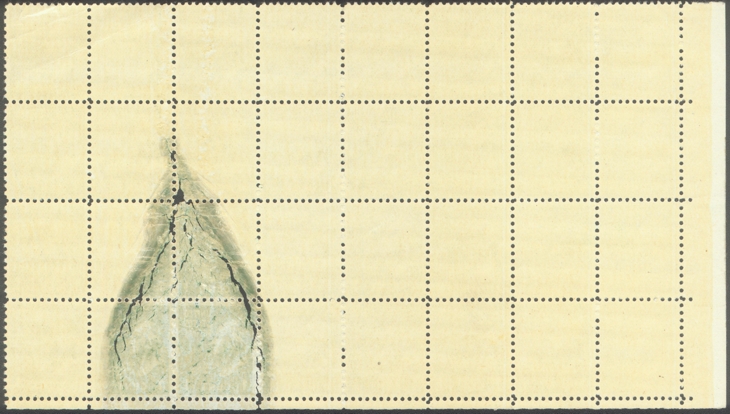
Type 51: The "slime hole" was caused by inadequately mixed chemicals in the paper-making process.
Linn's Article by John Hotchner
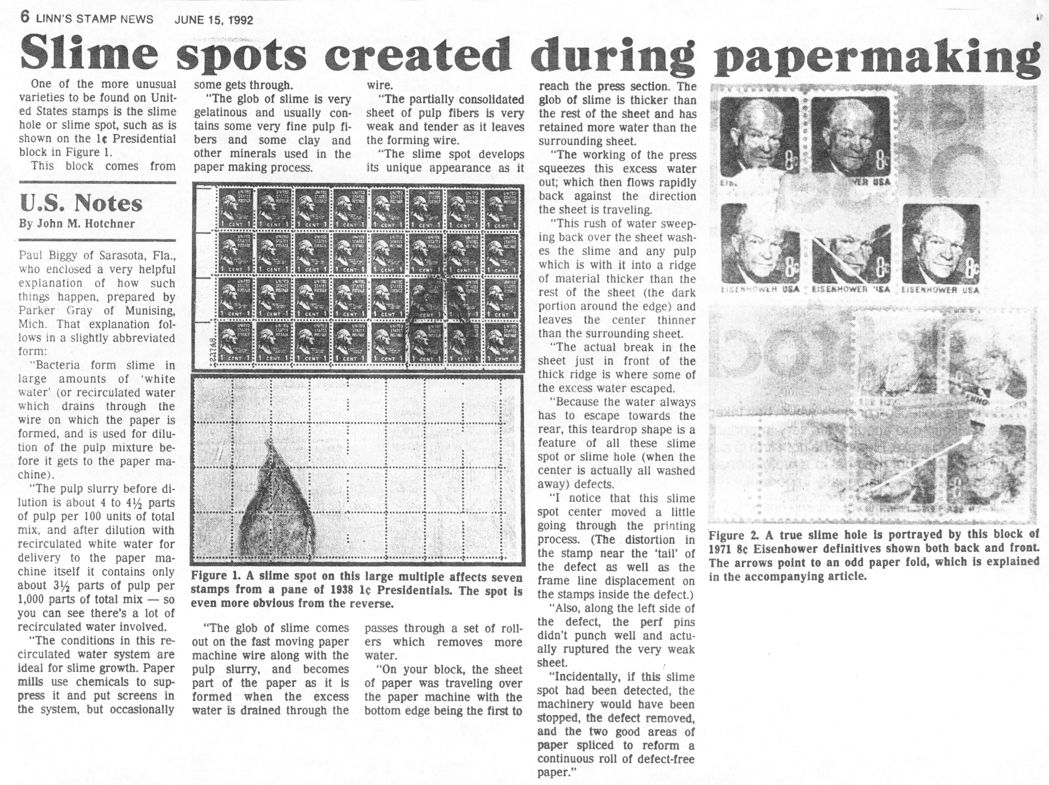
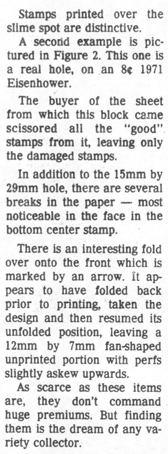
52. Non-error grill varieties: In this category are split grills, sometimes combined with a subsequently placed normal grill. Worth derives from the value of the basic stamp with an additional amount based on how unusual the variation is.


Type 52: A Scott 93 with a 9x13 split grill which can be seen when looking at the back of the stamp on the right.
53. Unprinted areas in the stamp design: Printing gaps have a multitude of causes. Among them are problems resulting from water content at the time that the paper was moistened before intaglio printing, inadequate ink on the plate, cleaning solvent dissipating the ink, foreign matter on the paper such as hairs and bugs, a disengaged plate, a weak spot on an impression roller, problems with paper coating and bubbles in the ink. Most are minor and have more interest than cash value.


Type 53: A weak spot in the suspension roller left a strategically-placed "snowball" in Lockwood's face (Scott 2178).

Type 53: Inadequately wetted down paper prior to intaglio printing left this stamp with a light impression from inadequately adhering ink (Scott 565).

Type 53: Foreign matter, such as the insect that landed on this stamp, results in unprinted areas in the stamp design (Scott 319g).
54. Excess ink on stamps: The examples most often seen are ink splatters, smears of various types, wiping flaws and markings from processing equipment that picked up undried ink from previous stamps and deposited it on trailing stamps. Wiping flaws are often seen on stamps of the 1960s to 1980s. Most evident are very thin, slightly angled lines on intaglio stamps ("hard streaks"), and fatter, blurred lines associated with photogravure printing ("soft streaks"). The latter results from clumping of ink behind the doctor blade that removes excess ink from the design area of the photogravure plate. They are common and command little in the way of a premium, unless unusually large or with more than one color involved. Less often seen, but also less visual and therefore even less valuable in general, are the hard streaks. They come from a flaw in the hard rubber wiper that removes excess ink from the plate surface. That flaw will trail a thin line of solvent-weakened ink until the blade is replaced.
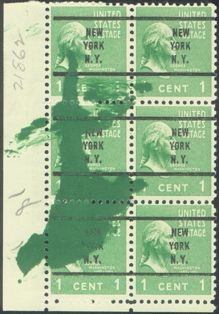
Type 54: A major ink splatter left excess ink on the final product (Scott 804).
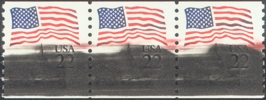
Type 54: A faulty wiping blade failed to remove the excess blue ink from the bottom of the plate that tprinted this coil (Scott 2115).
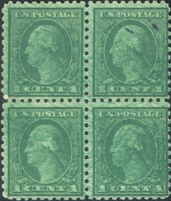
Type 54: Known as wet printing, the paper was too water saturated when the integlio plate applied the ink (Scott 543).
55. Excess ink between stamps: Beyond heavily printed and smeared joint lines, the freak to look for is joint lines where they shouldn't be. This is a unique property of Huck Press intaglio-printed stamps of the 1960s and 1970s that sometimes lead people to think they have a great unlisted rarity. Several curved printing plates were needed to make up a full circular printing sleeve. If the printing plates were fitted together perfectly, no joint line would show. If, however, any gap existed between the plates, it would pick up ink and deposit it between the designs. These lines were random, incomplete, and sometimes had mixtures of the colors of the stamps. They are collectible but do not receive catalog recognition. Because they are so prevalent in Huck printing, they don't as a rule have extra value. The exception is when they are strong and visual, but even then the extra value is modest.

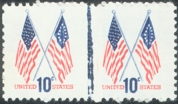
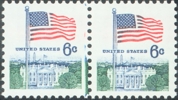

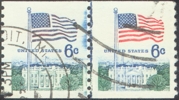
Type 55: These flag definitives are Huck Press printed, meaning that the printing sleeve was made up of several plates two subjects wide. If ink got between the plates, a joint line printed. Because such lines were irregular and unpredictable, they are not catalogue listed.
56. Color variations: Stamp designs used over long periods of time often can be found with differing shade varieties of their basic colors. The properties of the ink components can change, as can the quality and properties of the paper purchased by the printer. Those factors can affect the printed colors. New printing equipment, using the same plates and ink, also can result in shade and color-intensity differences. Unless pronounced, these shades are relegated to minor status and, though avidly collected by many, have little additional value.
The advent of photogravure printing in the late 1960s brought a whole new class of color varieties. Gravure is based on the sequential printing of four basic colors in carefully planned dot patterns, one on top of the other, to produce the impression to the human eye of every color of the rainbow. It produces much more colorful stamps. But it also causes collectors to notice shade differences more than ever before because a small difference in the inking of one color plate often has a dynamic effect on the final colors produced. Expertizers frequently see photogravure stamps submitted as missing-color candidates, when they are only a light print of one of the four basic colors. Thus, there is a range of normal for most photogravure stamps, and a stamp has extra value only if it falls outside that range.
Another group of color variations evolved from the Giori process, in which up to three colors are printed from a single plate. The ink is in wells that are one above the other at one end of the press. An inking-in roller takes the ink from its trough and applies it to its discrete portion of the plate. The excess ink is wiped off, and the stamps are printed. With such a complicated piece of equipment, many things can go wrong. Ink from one trough can fall into the trough below, leaving spots of the wrong color in the middle of the correct color. If a spill is large, an entire color can be changed as the two inks mix. If the wiping of the plate is not done carefully, one ink color can be wiped into the area of another. This is called an "ink bleed" or "contamination." If the inking-in roller is not properly aligned with the plate, design elements may appear partially the wrong color, depending upon how much the roller and plate are out of alignment. The alignment problem can be horizontal or vertical.
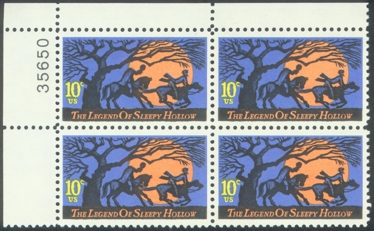
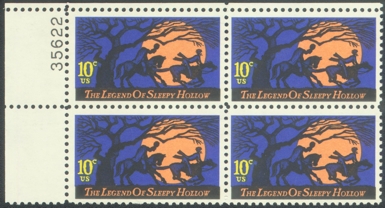
Type 56: Light and dark background blue colors are due to differences in ink application (Scott 1548).




Type 56: Four different shade varieties of the Presidential 4¢ Madison (Scott 808) that was produced over 16 years. It is characteristic of the Presidential series that color changed over time as production equipment and ink formulations changed.

Type 56: This is an example of the Giori misaligned inking in roller phenomenon, leaving the Flag severely discolored (Scott 1895).
57. Tagging varieties: Tagging should be viewed as just another ink, although a colorless one. Because it is colorless, values of varieties tend to be modest, but a collector can have a lot of fun with an ultraviolet light and a pile of modern U.S. stamps. Examples to be found will include those with partial tagging, light and heavy tagging, blotchy tagging, misplaced tagging, and differing sizes of tagging blocks and bars. One class of tagging flaw is visible. Called a "tagging ghost," it is most often associated with plate numbers. It happens when a sheet of stamps that has not completely dried passes through the offset press that adds the tagging. The tagging roller picks up ink from the sheet and deposits it on the next sheet passing through. Up to three ghost numbers on a single sheet are known. The entire design also can be ghosted, although that is rarely seen. Ghost plate number blocks are relatively common and usually go for two to three times their face value.


Type 57: As can be seen in this photograph, tagging blocks have shifted horizontally (Scott 2219).

Type 57: This block of Scott Scott 1538-41 has a triple plate number.

Type 57: An extreme tagging ghost such as this on a multiple of the 1971 21¢ airmail (Scott C81) only could have happened as a result of a misfed sheet.

Keywords: Huck press, intaglio press, Cottrell press, web nine color intaglio press,
Conlon, Bureau of Printing and Engraving, Sanders, BP&P, Stark, phosphorescent,
fluorescent, ultraviolet.
58. Printing on reverse: Stamps printed on early sheetfed presses are sometimes found with the reversed image of at least part of the stamp on the reverse. This was usually caused by placing a sheet on top of a wet sheet. If done before gumming, the impression of the sheet was transferred to the back of the sheet above. Most are light representations of the design, and value is modest.


Type 58: This copy of Scott 548 has an off-center impression on the back.
59. Doubled impressions: When paper passes twice through a press and the second pass is unintended, it is an error. But a variety exists that mimics the error, called a "kiss print," in which the plate stutters. The second impression produced is usually light, often inconsistent and not complete. These are common on the offset-printed Washington Heads of 1918-20 but have little value compared to the true double print. They are considerably more scarce on other issues, but the value is still not much more than the value of the stamp itself unless visually dramatic.
Doubling is also found on modem offset printed stamps when two or more offset colors are printed. The second offset roller can pick up wet ink printed from the first offset roller and print it on the following sheet. Because it should print exactly on top of the same offset color, this phenomenon would usually not be noticed. But if the next sheet is a hair off register, the second imprint will be visible.
A more frequently seen variety is what have come to be called "phantom" plate numbers - most often on web-printed Presidential-era plate margin strips. They are very light but easily seen second impressions of plate numbers and other marginal markings, but in the wrong location on the margin. The cause is the mechanism that cleans the roller that regulates the edge of the web. If the mechanism failed, or was in process of being adjusted, the roller picked up a bit of wet ink and deposited it where it didn't belong on the next revolution. Value for an affected margin block is in the $20 range, more for a larger piece or for multiples with little-used denominations or higher face values.
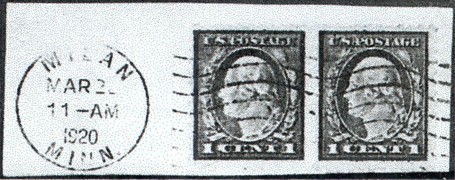
Type 59: The pronounced doubling in the left-hand stamp (Scott 498) is an example of a pulled (or kiss) print, not a double impression error. It occurred when the ink was pulled or dragged from its proper place by the paper moving under the plate.
60. Color misregistrations: By definition, this phenomenon involves stamps printed in two or more colors. Causes and effects are varied, from simple misregistration of a second color printed on a second pass, to misregistrations several stamps in length on modern web presses. Simple freak misregistrations between colors can be startling. Value depends upon the degree of misregistration, the colors involved and whether misregistration is a consistent problem on the issue involved. For instance, it is hard to find a precisely registered 1975 10¢ D.W. Griffith stamp. A high percentage are flawed.

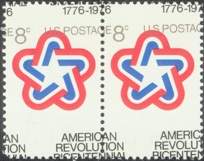


Type 60: These are examples of color misregistration from different eras and different equipment (Left to right: Scott 2285b, 1432, 294, 294).
61. Overprint and precancel problems: Stamps on which new information has been added in the form of words, values or precancels are a fertile field for the specialist. Some variations have been described in the Errors section, but there are plenty of freaks: misplaced and partial prints, stretched and compressed prints, flaws in the letters or numbers, missing periods or letters, and light and heavy impressions. Values vary widely according to the value of the basic stamp, how common the variety is, and how visually impressive the variety is.
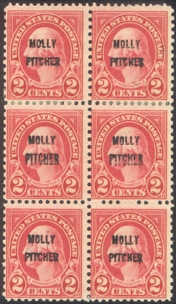
Type 61: "Pitcher" in the center stamps is streched (Scott 646).




Type 61: These precancels and the Shangai overprint show misalignment and the 5¢ Kansas City precancel has a thick bottom bar (Left to right: Scott 1054, 804, K17, 810).
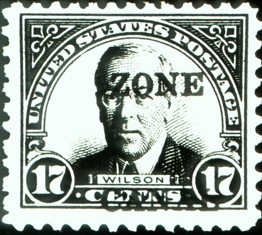
Type 61: Scott Canal Zone 91c is a variation of Scott Canal Zone 91, with the overprint shifted vertically such that overprint reads "ZONE CANAL" instead of "CANAL ZONE". This stamp is an overprint of Scott 623.
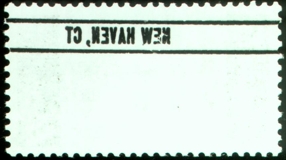
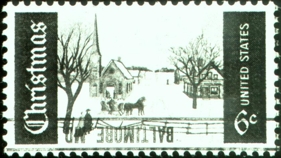
Type 61: Two precancel varieties for Scott 1384a: The left stamp shows no trace of precancel on front. The right stamp's precancel is reversed and shifted lower.
The July-September 2004 issue of The EFO Collector (Vol. 23, No. 6, pp. 24) contains an article by Stan Goldfarb
that describes many varieties of Scott 1384, including many precancel varieties, and is profusely illustrated.
62. Gum varieties: At one end of the spectrum in this category is partially missing gum, which has correspondingly little value. On the other end are gum inclusions, or tiny objects, such as hairs or insects, that get stuck in the gum or under the gum as it is applied. The more interesting the inclusion, the greater the value.
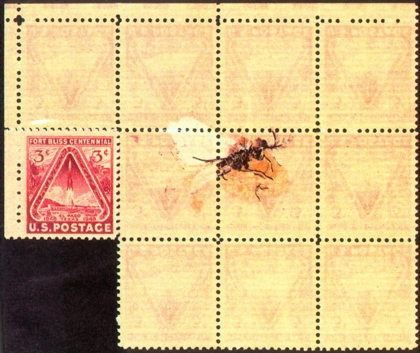
Type 62: A fly was caught on the gum of this block (Scott 976) during the production process. This was in the era when the Bureau of Engraving and Printing had no air conditioning, so during the summer the windows were open and anything might fly in.
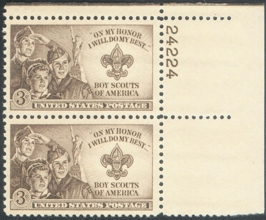
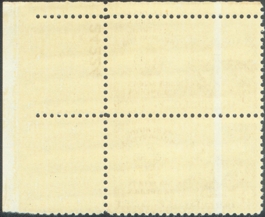
Type 62: A vertical gum skip leaves a small ungummed line (Scott 995).
63. Essays, proofs and specimens: Essays are defined as design trials. Proofs are printed versions of an approved design to test the design itself, the printing equipment, or one or more possible colors for the issued stamp. Specimens are specially printed versions of the issued stamp, usually marked as such for purposes of record or display. All are scarce, having been produced in small quantities, and most have significant value.

Type 63: A specimen overprint appears on the 1¢ Franklin Navy Department Official (Scott O35S).

Type 63: A proof of the 1¢ Franklin Treasury Department Official (Scott O72P).
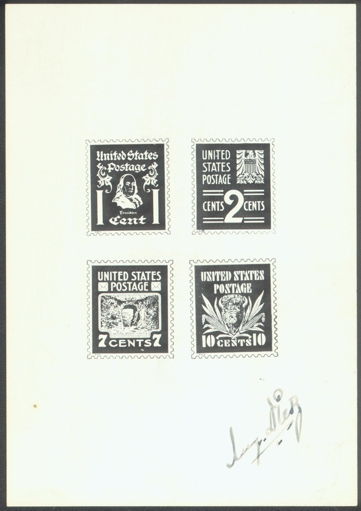
Type 63: Essay for Presidential Series by August Dietz.

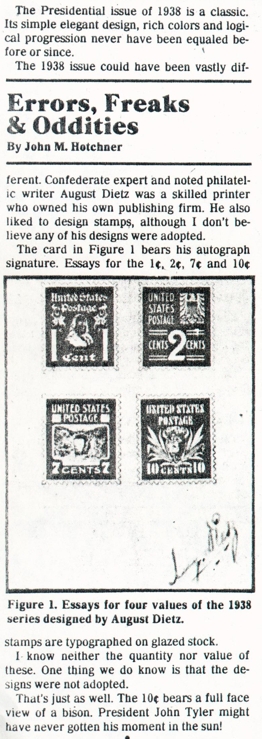

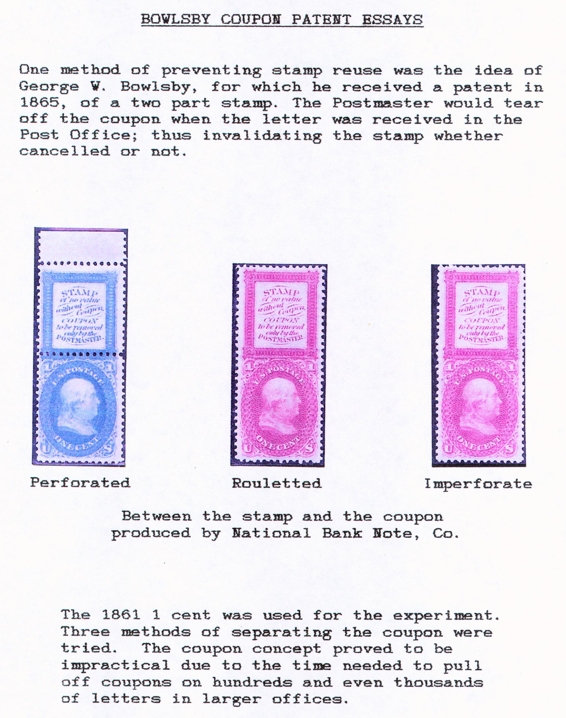
64. Plate varieties: Also called sometimes plate flaws, included in this category are double transfers (what our British and Canadian friends call "re-entries"), position dots, plate cracks, die flaws, relief breaks, worn plates, plate damage and repairs. Also included is any physical alteration to the plate, intentional or not, resulting in a nonuniform stamp that can be identified and matched to a specific location on a plate. While mostly collected in the United States on intaglio-printed stamps, plate varieties can be found associated with other types of printing. The values of these items relate to the basic stamp and the visual degree of the plate variety.
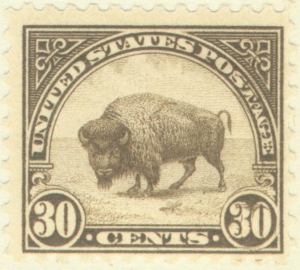
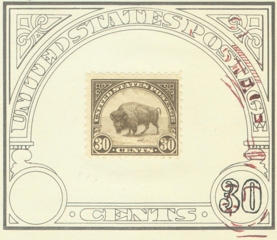
Type 64: A dropped transfer occurred on plate 16065, position U.R. 52 of Scott 569.
65. Design errors: Faulty research in designing a stamp can result in an issued stamp that contains an error, an inherent contradiction or misinformation. This can be in the stamp's design, in a backprint or in a marginal inscription. Since all issued stamps will contain the same error, they have no special value.
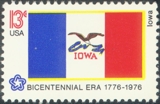
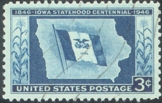
Type 65: Which is the proper flag design for the Iowa flag? (Left: Scott 1661, right: Scott 942)
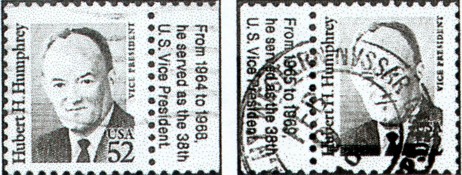
Type 65: The U.S. 1991 52¢ Hubert Humphrey stamp (Scott 2189) at left was printed with the wrong dates ("1964 to 1968") for Humphrey's term as vice president. The stamp was printed a second time with the correct dates, "1965 to 1969."
66. Counterfeits, fakes and intentionally created varieties: While some shun "created" and altered stamps, there are a lot of collectors who find them fascinating, if only as reference material for use in expertizing the genuine stamps. Some of the better examples in this category have significant value, especially counterfeits that have seen postal use. Chemically altered stamps, on the other hand, have little value. Stamps on which the colors have been altered by chemicals or by prolonged exposure to light are called changelings and are considered curiosities.
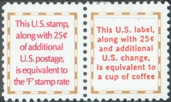
Type 66: Friend Wayne Youngblood has a little fun poking fun at the 4¢ make up rate stamp of 1991 (Scott 2521).

Type 66: How to make a "white" Old North Church? Dip the stamp in a common household product, and it will remove the blue coloring of the paper (originally, Scott 1603).
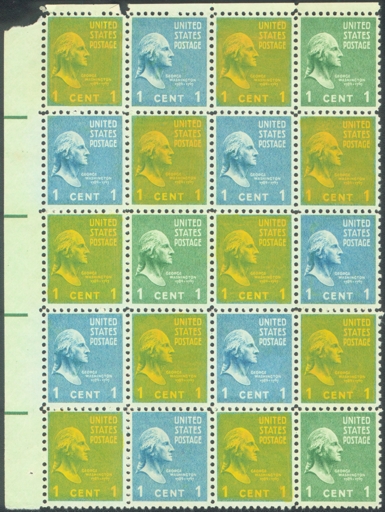
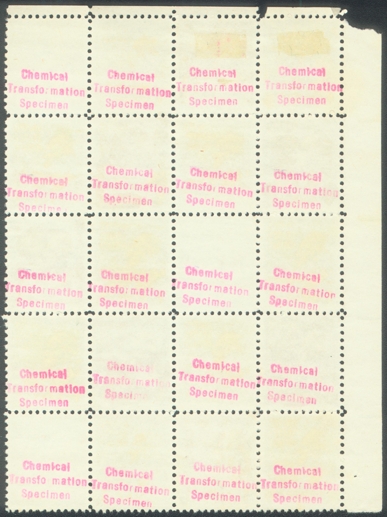
Type 66: Experiments with various chemicals left several different versions of the 1¢ Presidential of 1938 (Scott 804).
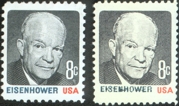
Type 66: The copy of Scott 815a on the right is a counterfeit.
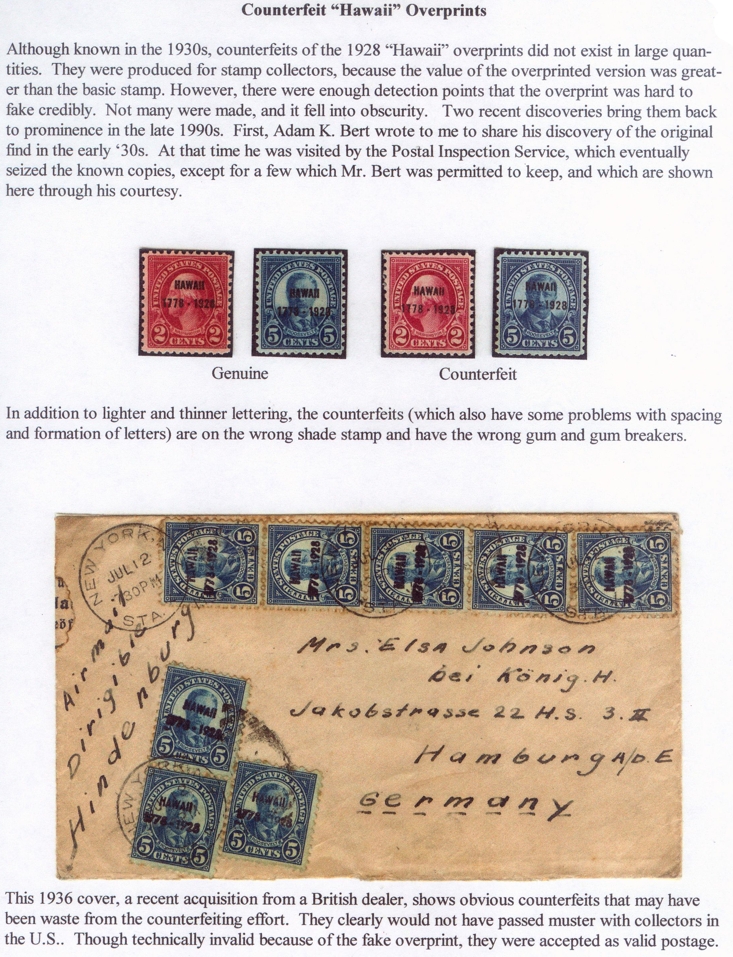
67. Rotary coil end strips: When coil rolls were made by hand, a leader and end strip were added to the roll with information about the face value and the number of stamps included. They are usually collected attached to stamps from the roll, and have little additional value.


Type 67: An example of a rotary coil end strip (Scott 1055).
68. Flat-plate coil paste-ups: The first coils, before rotary printing, were made by pasting sheets together. Side margins were pasted underneath the bottom stamp of the next sheet. The most interesting of these are paste-ups that show a plate number. A premium is paid for these items.
69. Private perforations: In the era of imperforate stamps, people sometimes used oddly punched holes, sawing machine holes or rudimentary roulettes to ease separation. Most have significant value. Before government-issued coil stamps were widely used, vending and affixing machine manufacturers purchased imperforate sheets of stamps from the Post Office Department and applied their own methods for separating stamps. They used holes, slots or slits between the stamps. Private perforations are very desirable items on cover, in vending booklets and as mint strips.

Type 69: Schermack Type III slots were used in coil dispensing machines in the early days of coil production (Scott 408).

Type 69: Mact-O-Meter Type II slots used on Scott 371.

Type 69: Brinkerhoff Type I slots used on Scott 320.
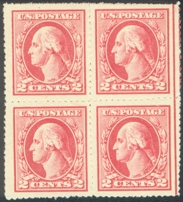
Type 69: These are so-called "Wilson Roulettes". Click here for additional information on "Wilson Roulettes".
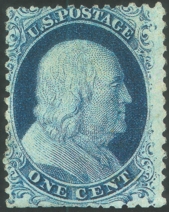
Type 69: Scott 9, design type II, position 84R3, with rough sewing machine perforations unofficially added (pictured at 400% of original size)..
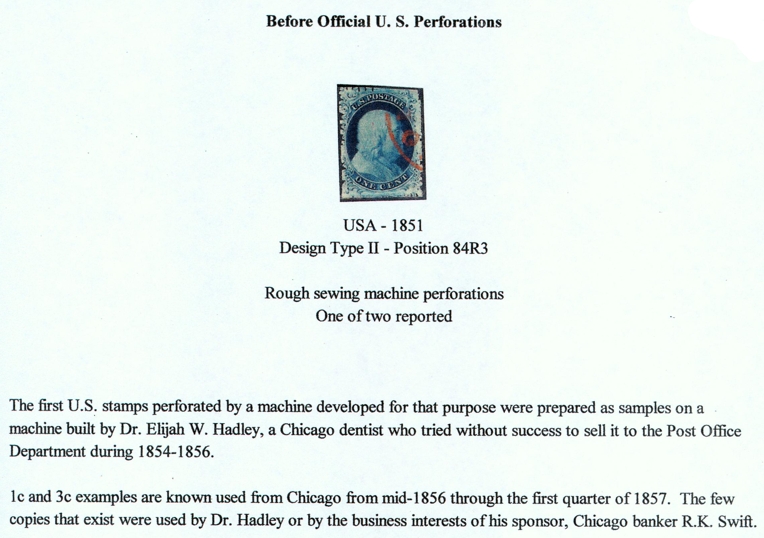
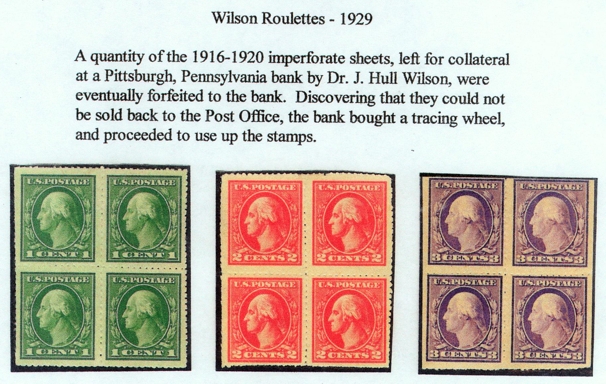
70. Semi-official separations: Included in this category are items like the Kansas City Roulettes, done with rouletting wheels by the Kansas City Post Office when it became necessary to sell to the public a quantity of leftover imperforate l¢ and 2¢ Washington Heads in 1914. A block of these is in the $75-$100 range.
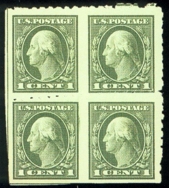
Type 70: Kansas City roulette used on Scott 408.

Type 70: Scott 11, position 66R4, perforated at 12 1/2 on a flat bed perforator - the so-called "Chicago Perf" - prepared by Chicago dentist Elijah W. Hadley, who tried without success to sell the process to the Post Office Department. Hadley eventually used his samples on mail, with no objection from the Chicago Post Office, which had recommended Hadley's process favorably to Washington.
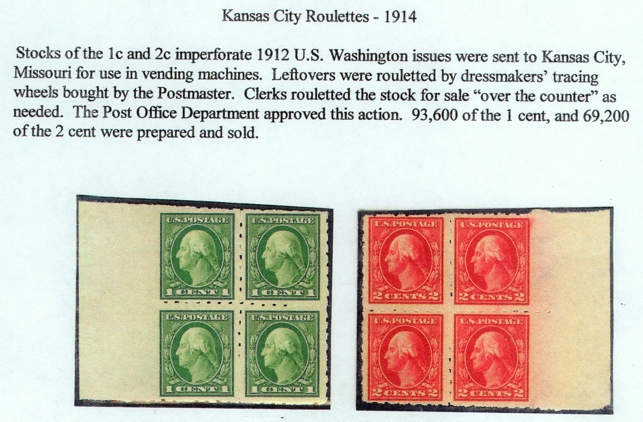
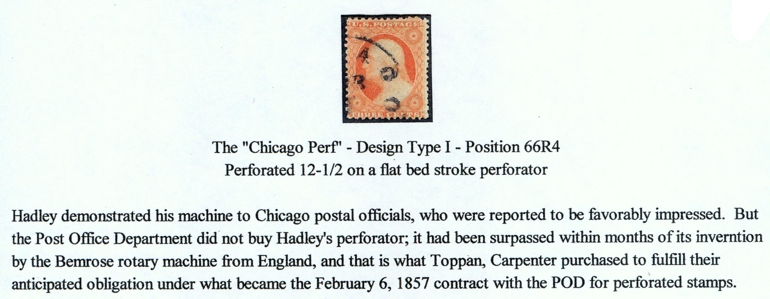
71. Bisects: These are stamps that have been cut in half to use only part of their face value to mail a letter. While the great majority of them have no official standing, many have been used and accepted when the stamps of proper rate have not been available. If it can be shown that a bisect on cover was permitted by postal authorities, it can have significant value. Others have only curiosity value.
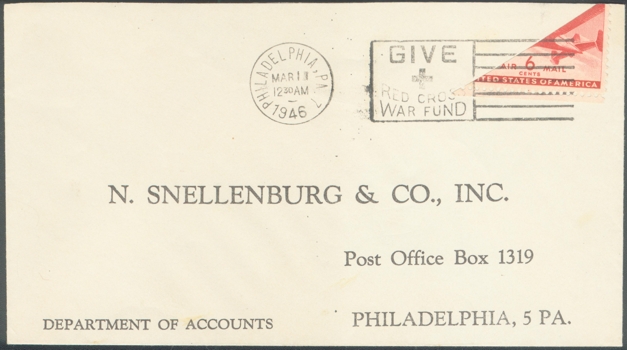
Type 71: An unofficial bisect (Scott C25) which pays the 3¢ first class rate. Probably slipped through the system without being noticed.
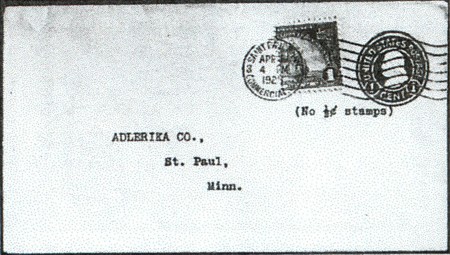
Type 71: Bisects were used in St. Paul, Minn., when the third-class rate was increased to 1-1/2¢ on April 15, 1925. Stamps were bisected by scissors or halved by perforators. The bisects were accepted by the local postmaster, but not authorized by Washington. The bisect used here is half of Scott 614.
72. Spacing and sheet layout varieties: In the first third of the 20th century, the Bureau of Engraving and Printing experimented with different vertical spacing between stamps to try to cut down on waste from inaccurate perforating. Spacing varieties can be identified by measuring the margin or by the presence of special plate numbers and other markings, such as different types of stars. Position pieces can have significant value.

73. Other experiments: Many experiments have been conducted over the years that have resulted in the issuance of unusual stamps. Examples are Banknote double papers and other varieties aimed at reducing the removal of cancellations, blue and clay papers in the Washington Heads to control paper shrinkage, and Silkote paper on the 1954 2¢ Jefferson to improve the printed impression. All exist in limited quantities and have significant additional value.
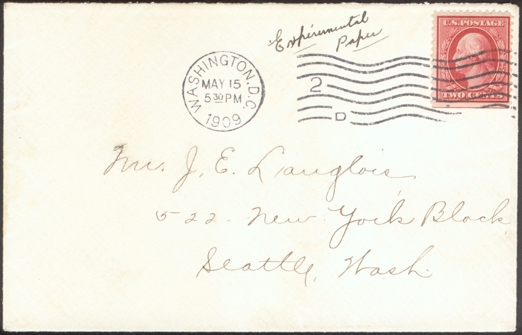
Type 73: This cover shows a postal use of Scott 359 printed on blue, high rag content, experimental paper. The objective was to control shrinkage and reduce poor registration of perforations. The experiment was a failure.
74. Test stamps, coils and booklets: Officially prepared for testing production or dispensing equipment, these "stamps" can be in one of several designs, but blank booklet panes and coils also have been produced. Some of this material is extremely scarce and sells for hundreds of dollars, but much is fairly common. It is listed in the Scott Specialized Catalogue.

Type 74: A linerless self-adhesive test stamp strip.
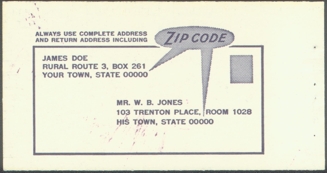
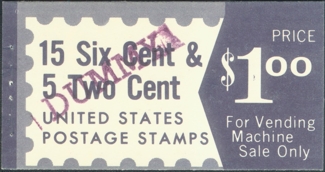
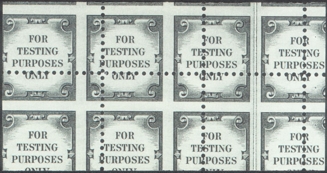
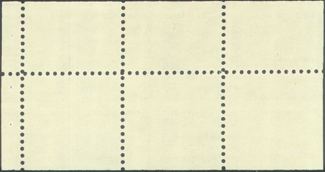
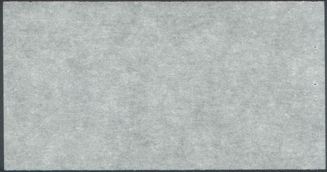
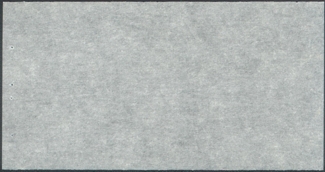
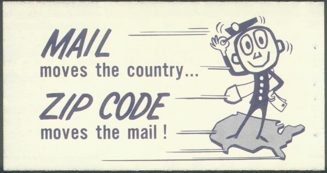
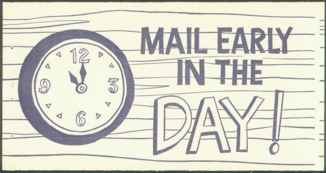
Type 74: This exploded booklet shows test stamps printed in coil format, but cut into booklet panes.
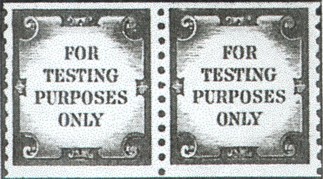
Type 74: Test coils have been prepared for testing production and dispensing equipment.
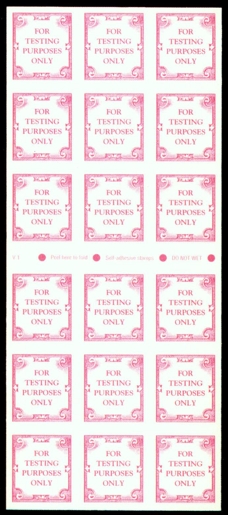
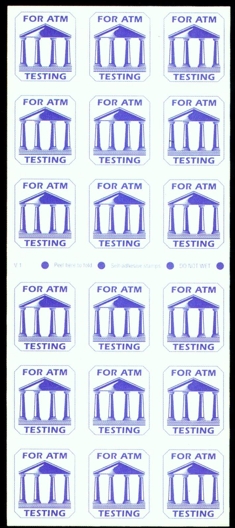
Type 74: Self-adhesive test stamp booklets.
75. Printer's waste: Every printing operation has waste, and the vast majority of it is destroyed. What reaches the public often is material that was sold for scrap or was on the way to destruction when someone appropriated it to try to make a profit. Even though it is tainted as far as collectors are concerned, it is still desirable and often has significant value.
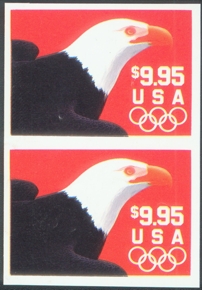
Type 75: Incomplete production, such as this imperf, engraved black missing Scott 2541, is easily identified as printer's waste, probably stolen.
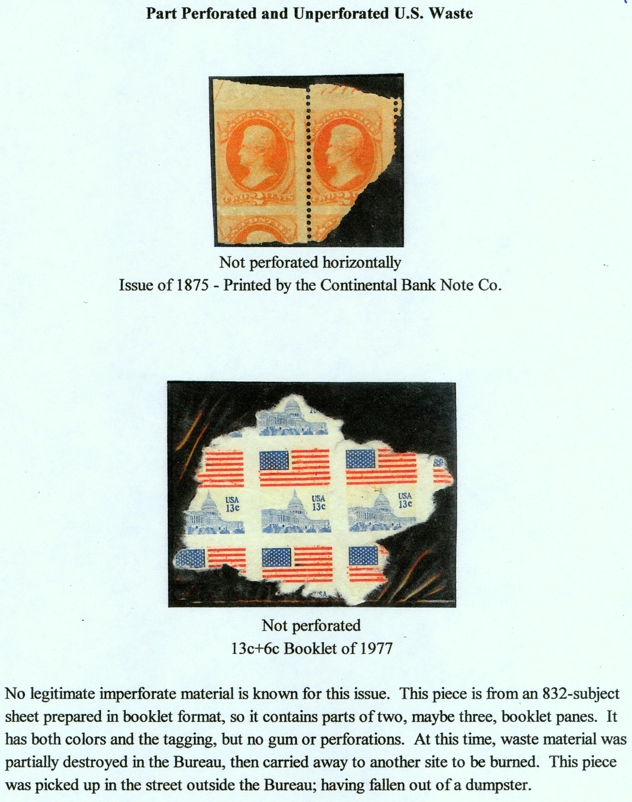
76. Different perforations on stamps of the same design: The use of random pieces of perforating equipment to complete printed stamps has a long and honorable history. After all, the printer usually cares only that the stamps are finished and salable. How that happens is the problem of the technicians. As an example, the American Banknote Co. prepared three different versions of the 1979 John Paul Jones stamp (perfs 12x12,11x12 and 11x11), and didn't think to tell the Postal Service. There are about 35 U.S. issues that exist with two or more different perforations but don't receive separate major catalog recognition. Most have no premium, but the John Paul Jones perf 12 by 12 and a few others have significant value.
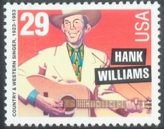
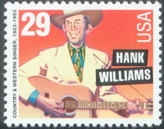
Type 76: The top stamp (Scott 2723A) has 22 horizontal perforations, whereas the bottom stamp (Scott 2723) has 20.
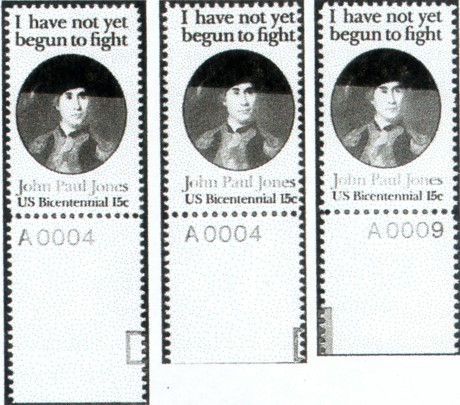
Type 76: The 1979 John Paul Jones stamp was issued with three different perforation measurements. Above are shown copies with perforations, from left to right, 12x12 (Scott 1789B), 11x12 (Scott 1789) and 11x11 (Scott 1789A). The 12x12 is rare with under 150 reported examples.
77. Local precancel varieties: Most precanceling was done at the local level, and the quality control was hardly equivalent to that of the Bureau of Engraving and Printing. Varieties abound, including inverts, partial prints, doubled and tripled impressions, misspellings and misregistrations. For the most part, they have little value, and then only to specialists who know how to evaluate their relative scarcity.
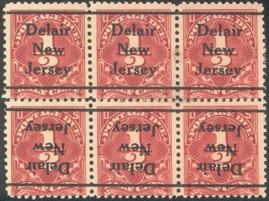



Type 77: Some of the variations that can be found on local precancels. From left to right: Scott J68, 566, 803, 560.
78. Perfin varieties: Perforated initials, or perfins, are applied to stamps as a security measure to keep employees or unauthorized persons from using them. All are done locally and varieties include doubled, impressed from the back or front, pairs with one missing, and others. Values are greater among specialists.
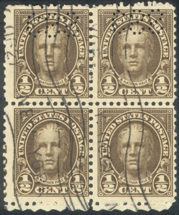
Type 78: The perfins are missing on the bottom pair of this 1/2¢ Nathan Hale block (Scott 653).
79. Cancellation and meter varieties: Inverted date and time slugs are common, as are smeared and inverted cancels or meter impressions, and other varieties. These mostly have curiosity value.

Type 79: These two PVIs show that for a period of at least 9 days, the Merrimack, NH, post office loaded the PVI blank stock upside down.
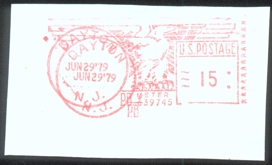
Type 79: A partial first impression of this meter prompted the user to redo it so as to show the postage paid.
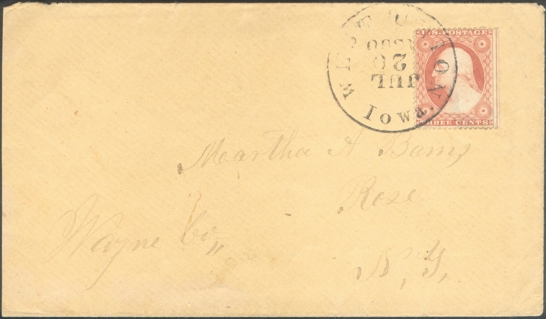
Type 79: The date slugs for the July 20, 1860, cancel were inverted when put into the hand stamp.
80. Pre-first-day cancels: These used to be the exception rather than the rule and occurred only when a postal clerk didn't notice the release date. It now is common for stamps to be used before their first day, Linn's periodically publishes an updated list of current issues and invites readers to find the earliest usages. Unless one finds the earliest pre-FDC date, the values are minor.
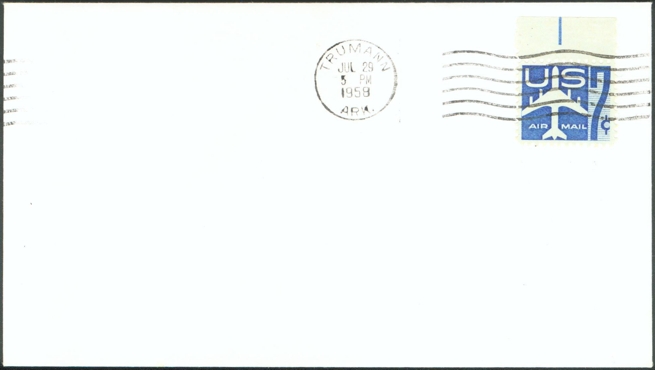
Type 80: This cover shows a prerelease of the 7¢ airmail stamp (Scott C51). The cover is postmarked July 29, 1958. The stamp's first day of issue was July 31, 1958.
81. Cinderellas: There are thousands of fantasy stamps and stamplike creations. Among the most interesting are those created to mimic genuine stamps for use in movies and advertising.

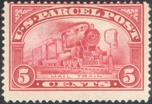
Type 81: A movie stamp cinderella (left) modeled on the U.S. Parcel Post issue of 1913 (right) features a mail train.
82. Unissued stamps: At times, stamps have been produced but not issued for a variery of reasons. For example, the unissued "H" stamp was likely sold over the counter by a postal clerk who did not follow instructions.

Type 82: The unissued "H" stamp (Not listed in Scott).
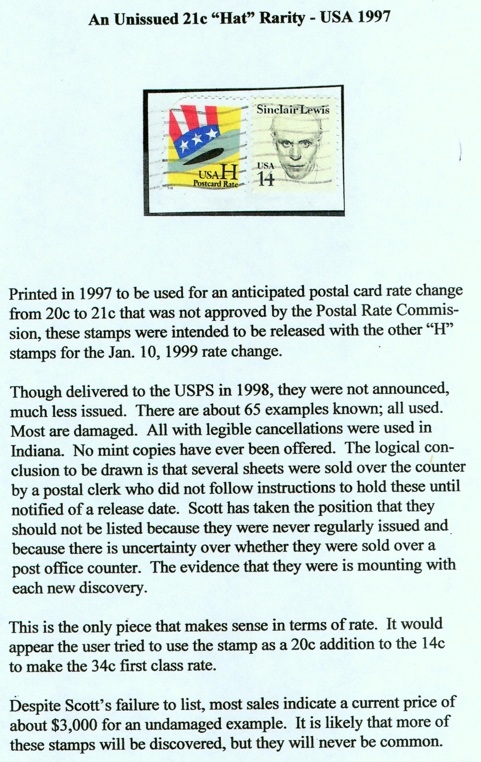
...brought to you by
 Please visit us at https://www.efocc.org
Please visit us at https://www.efocc.org

























































































































































































































